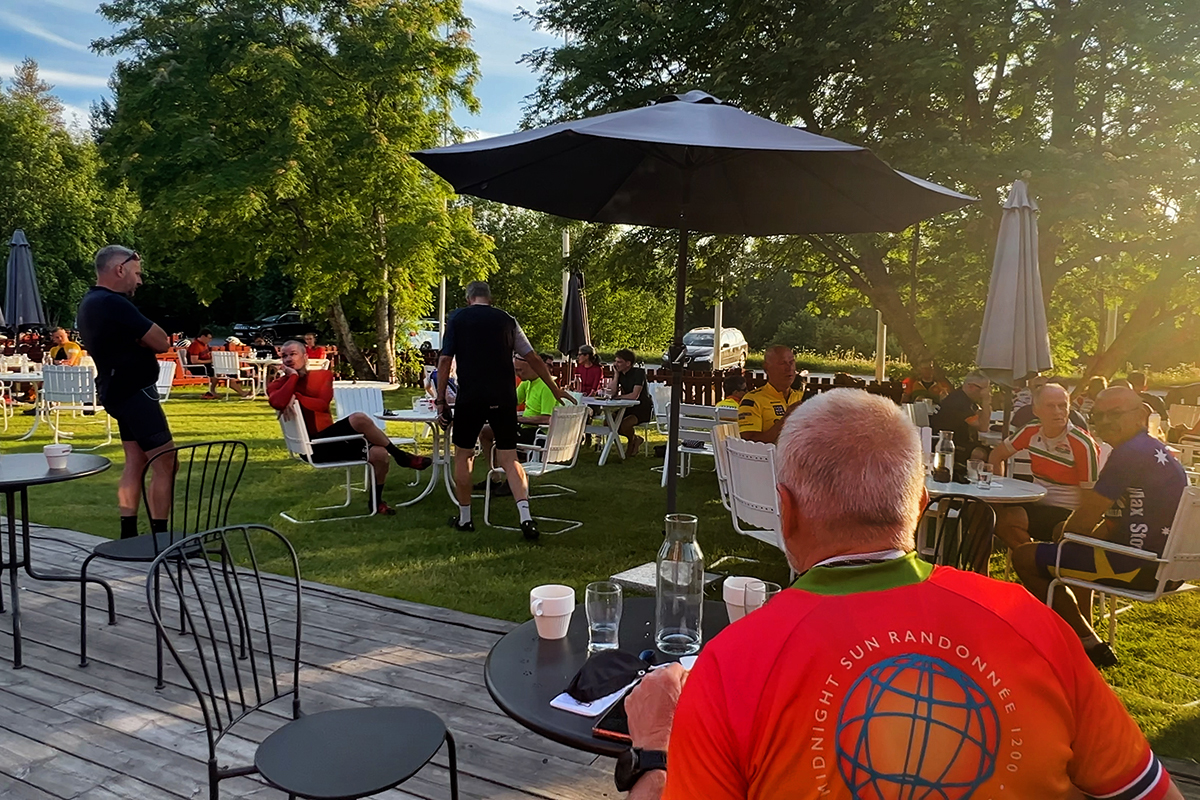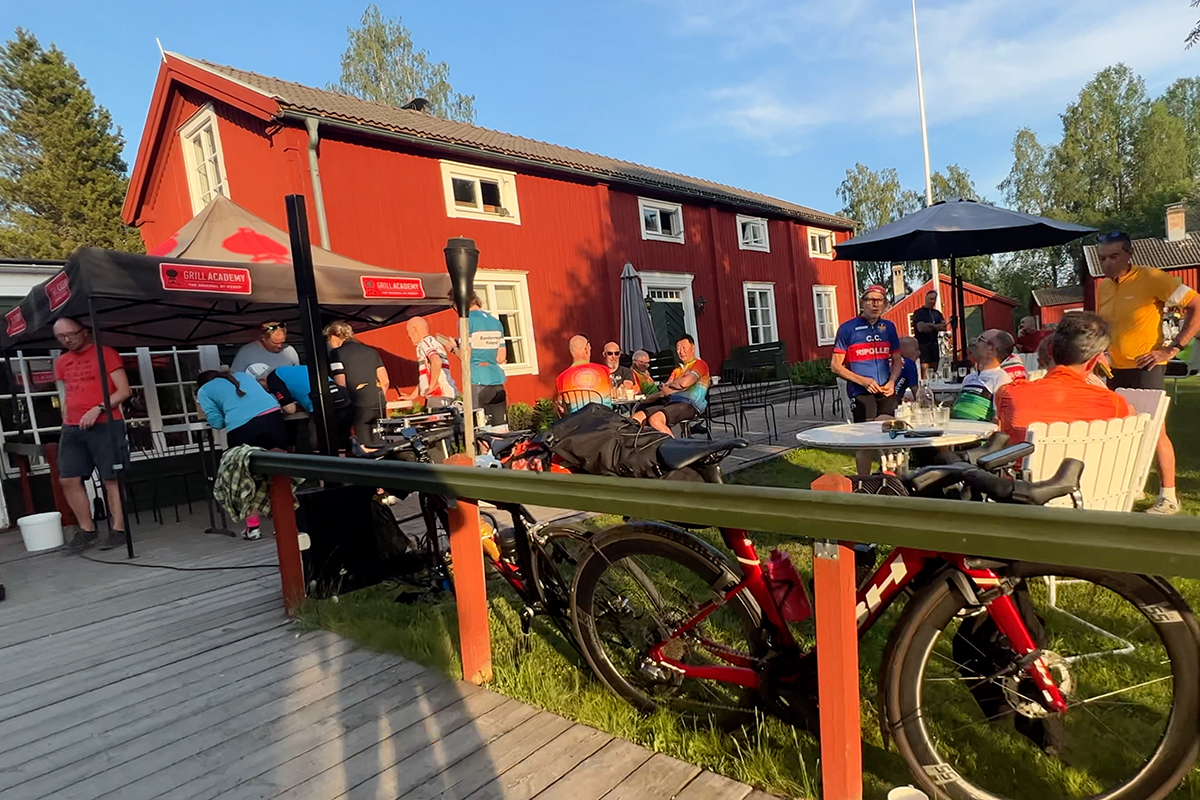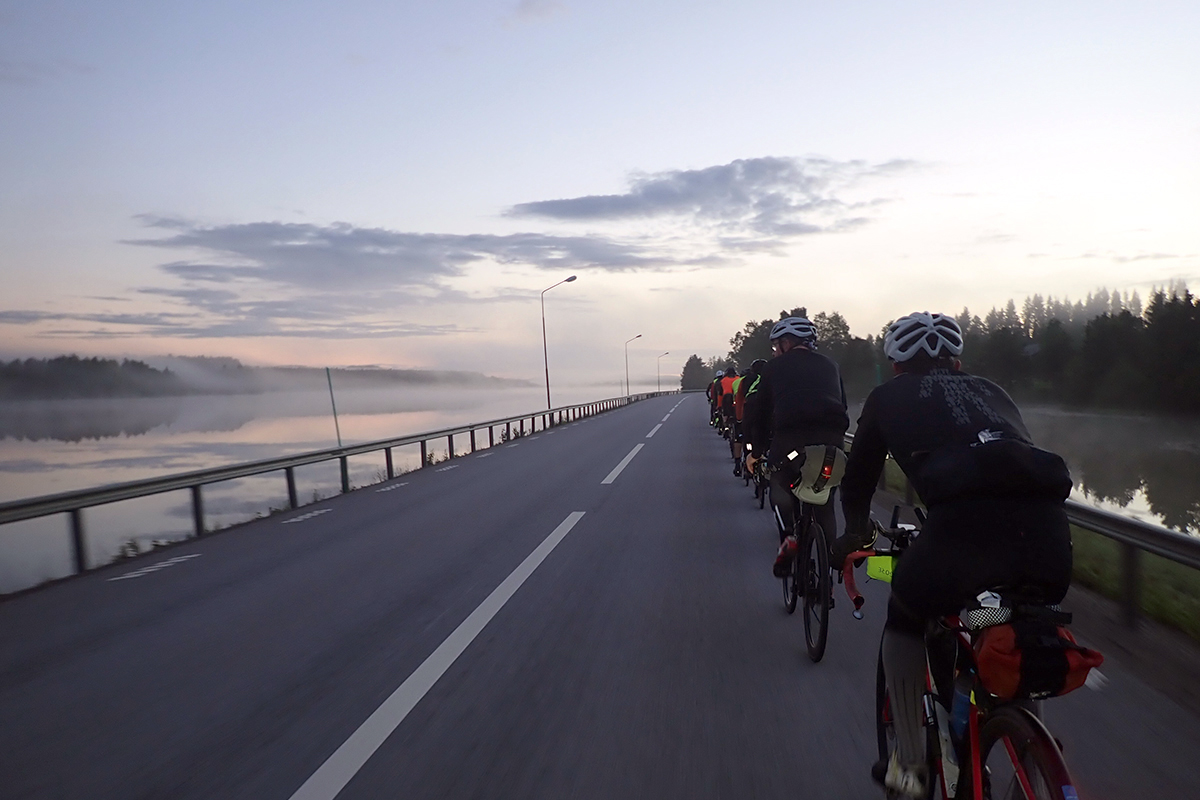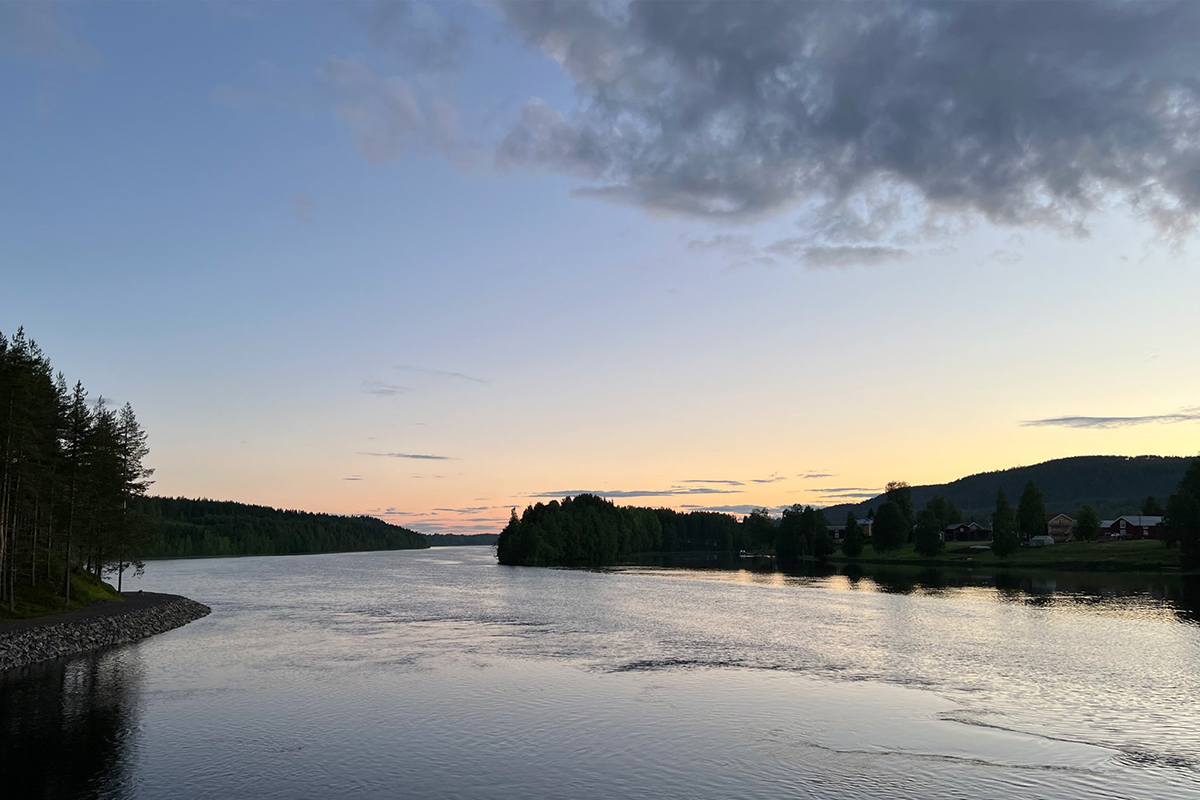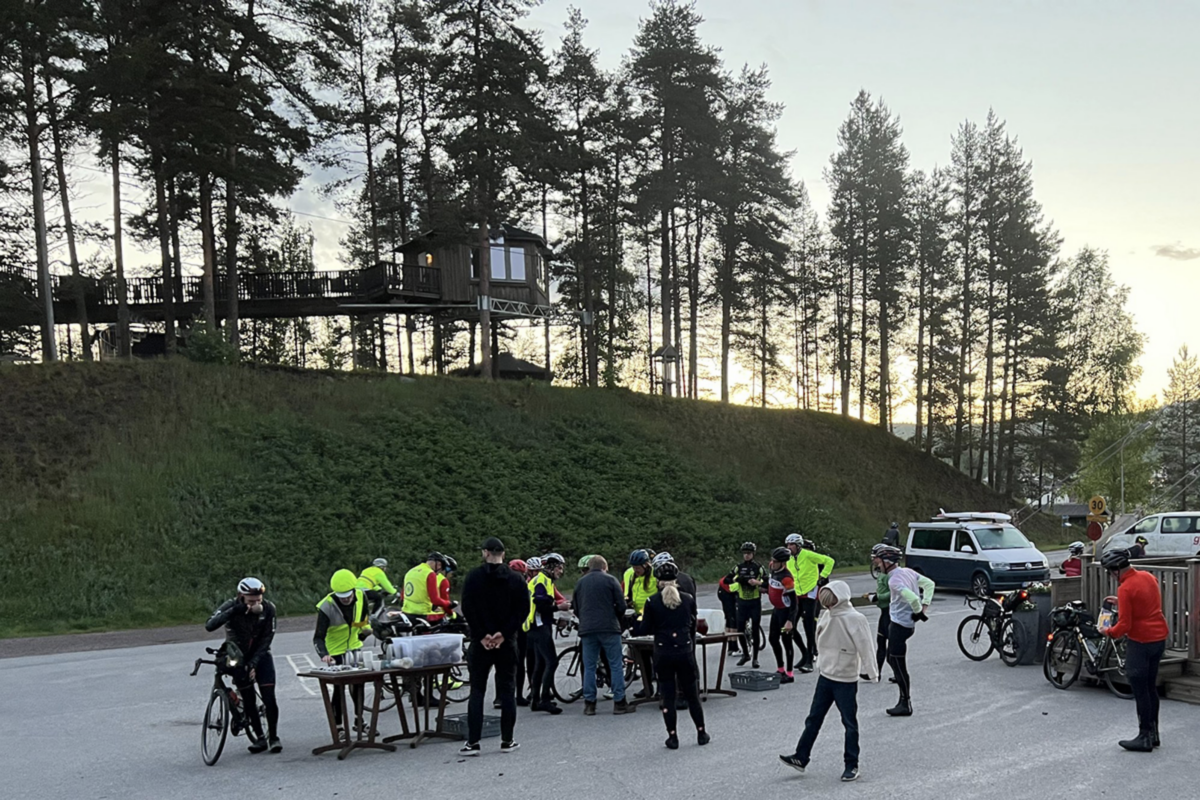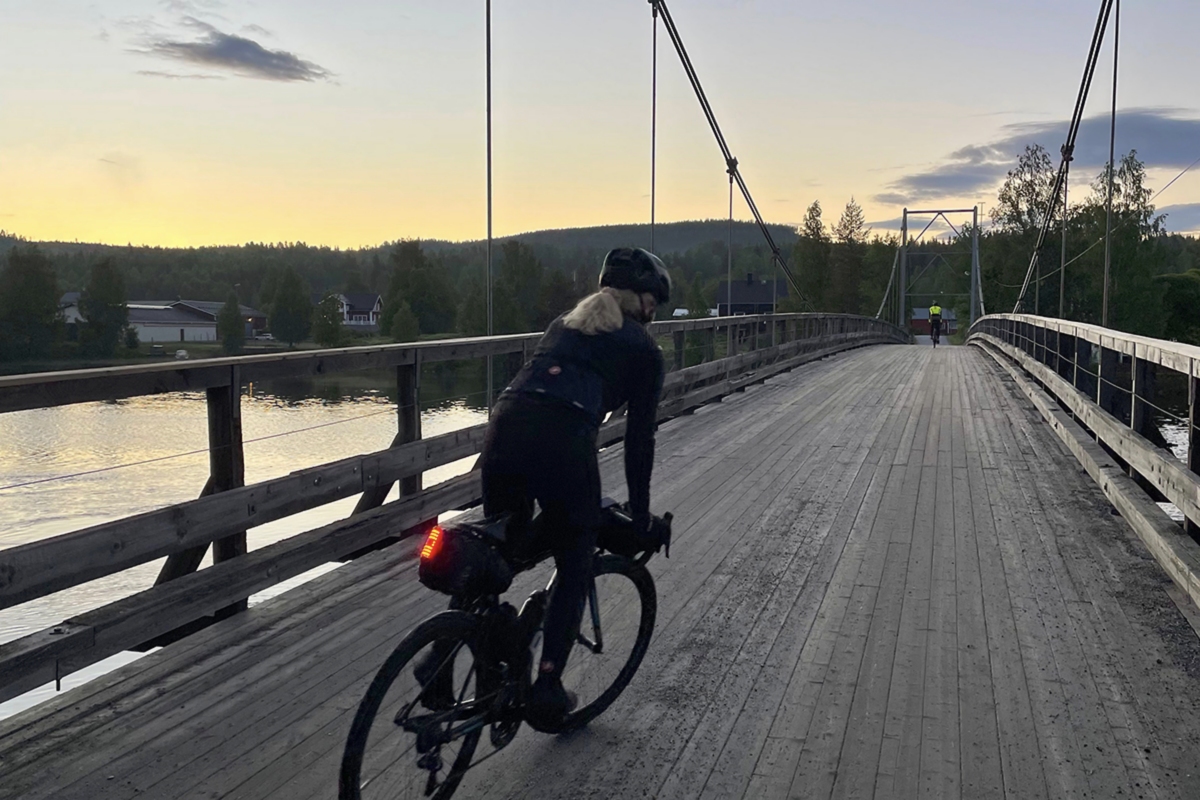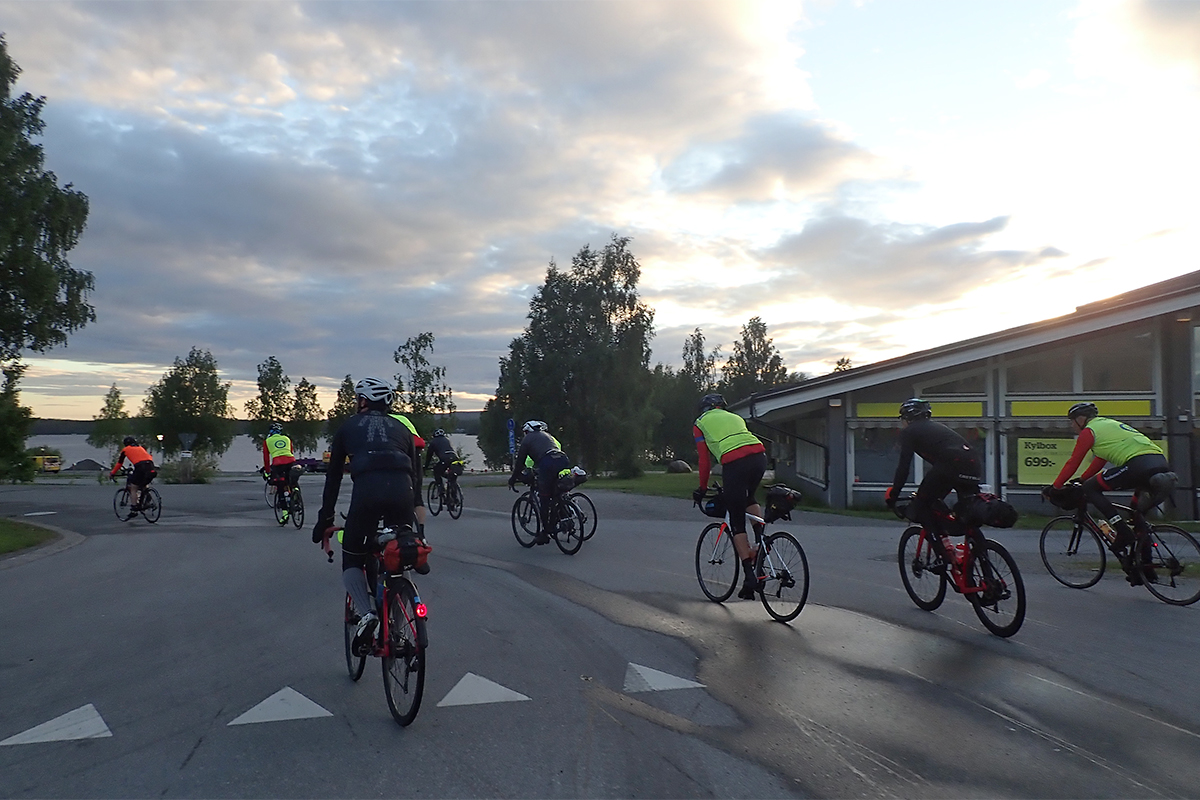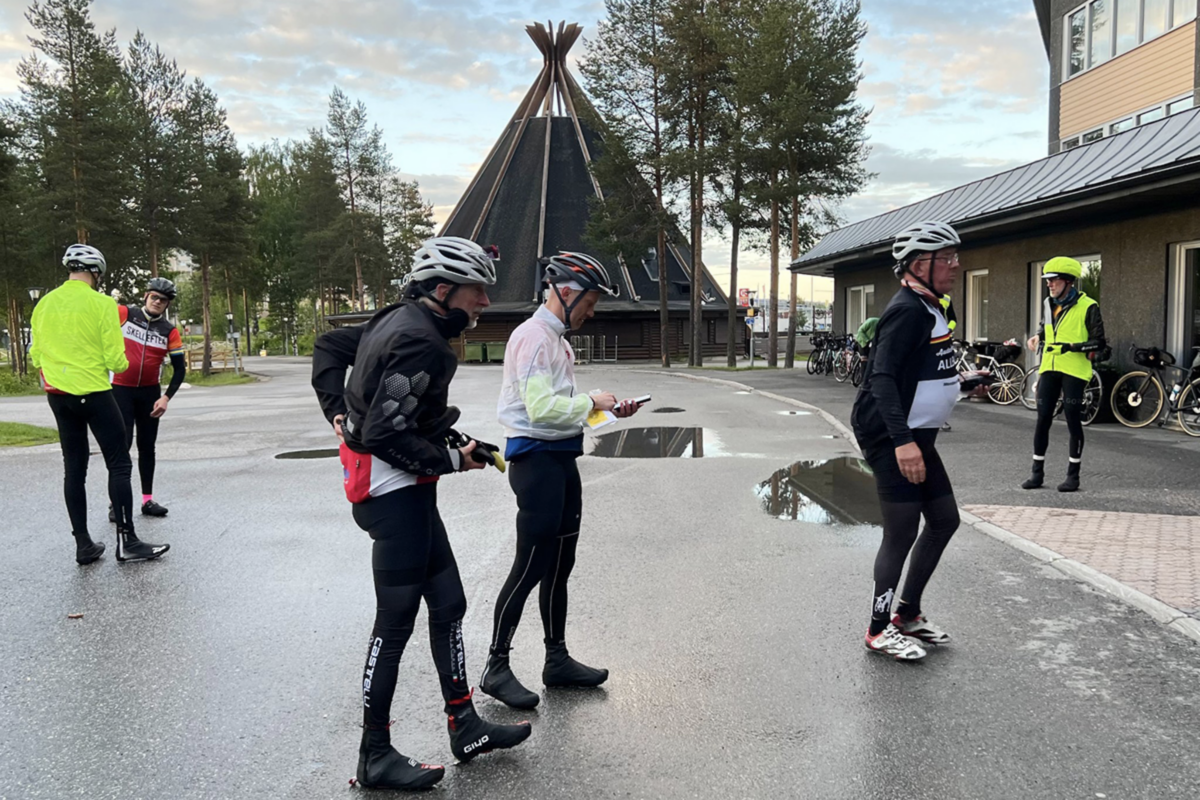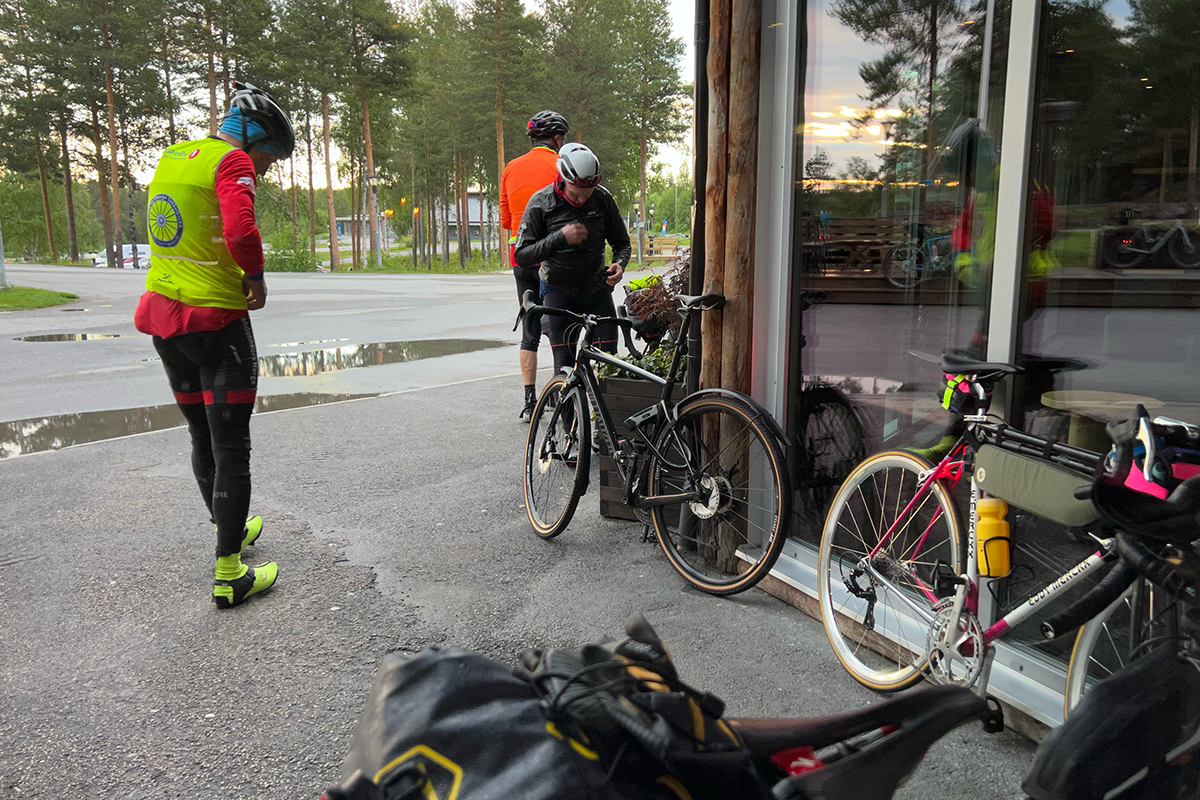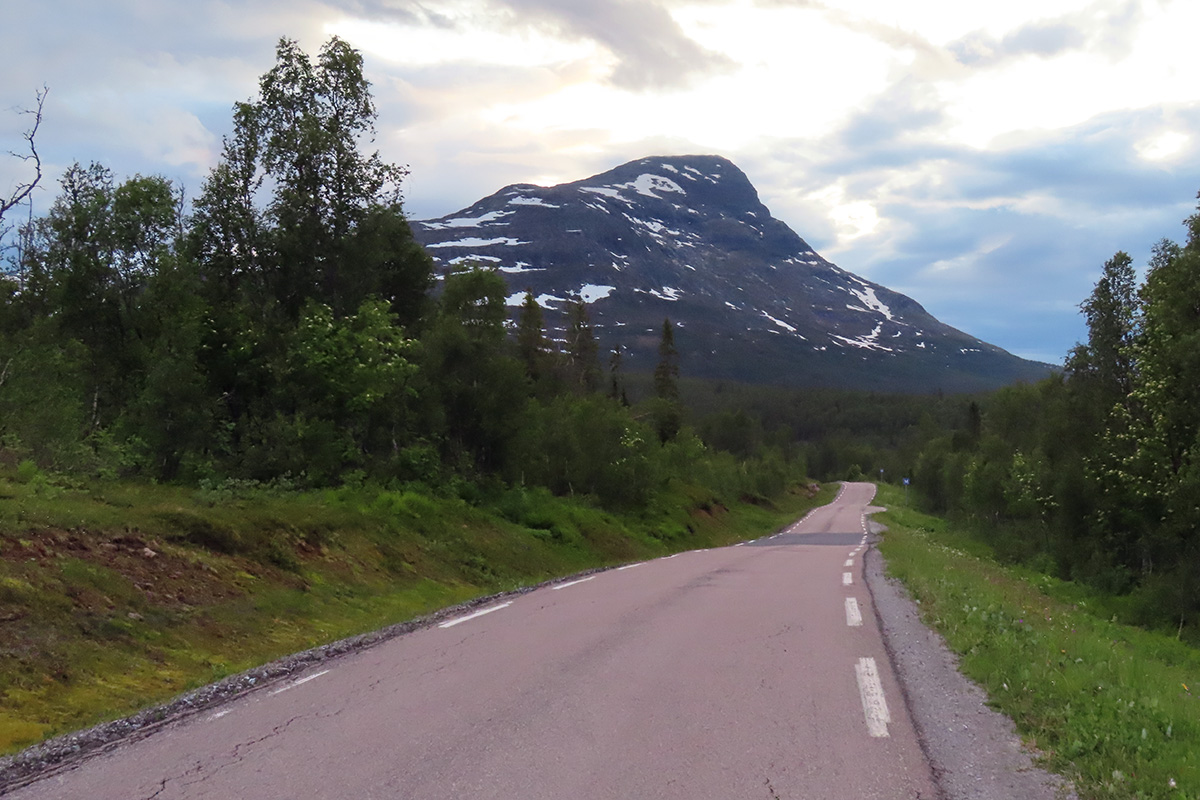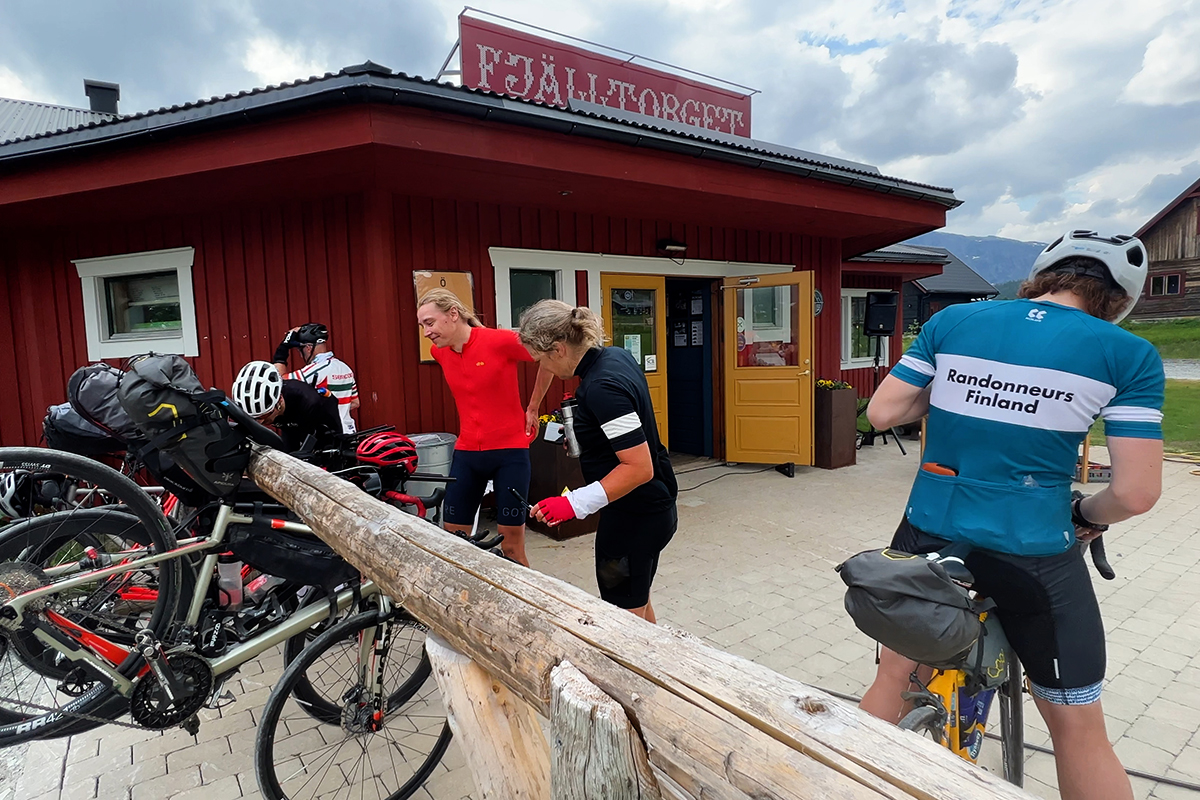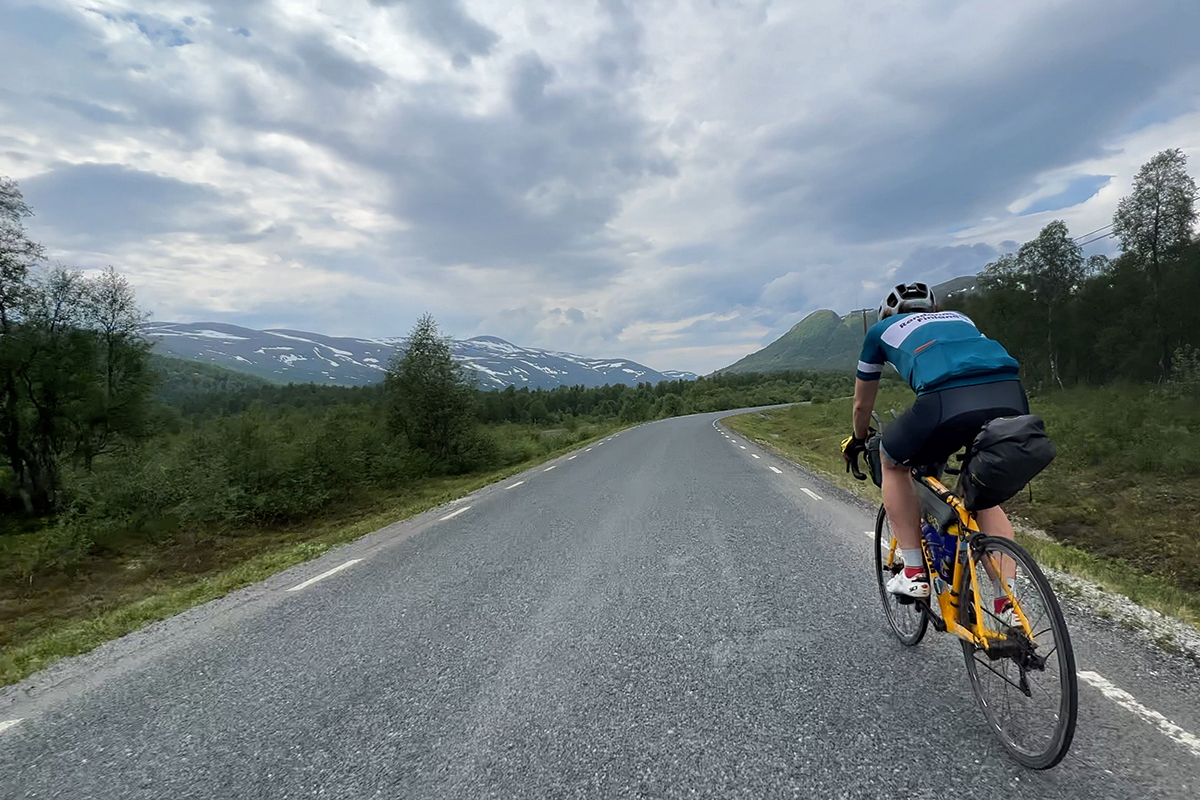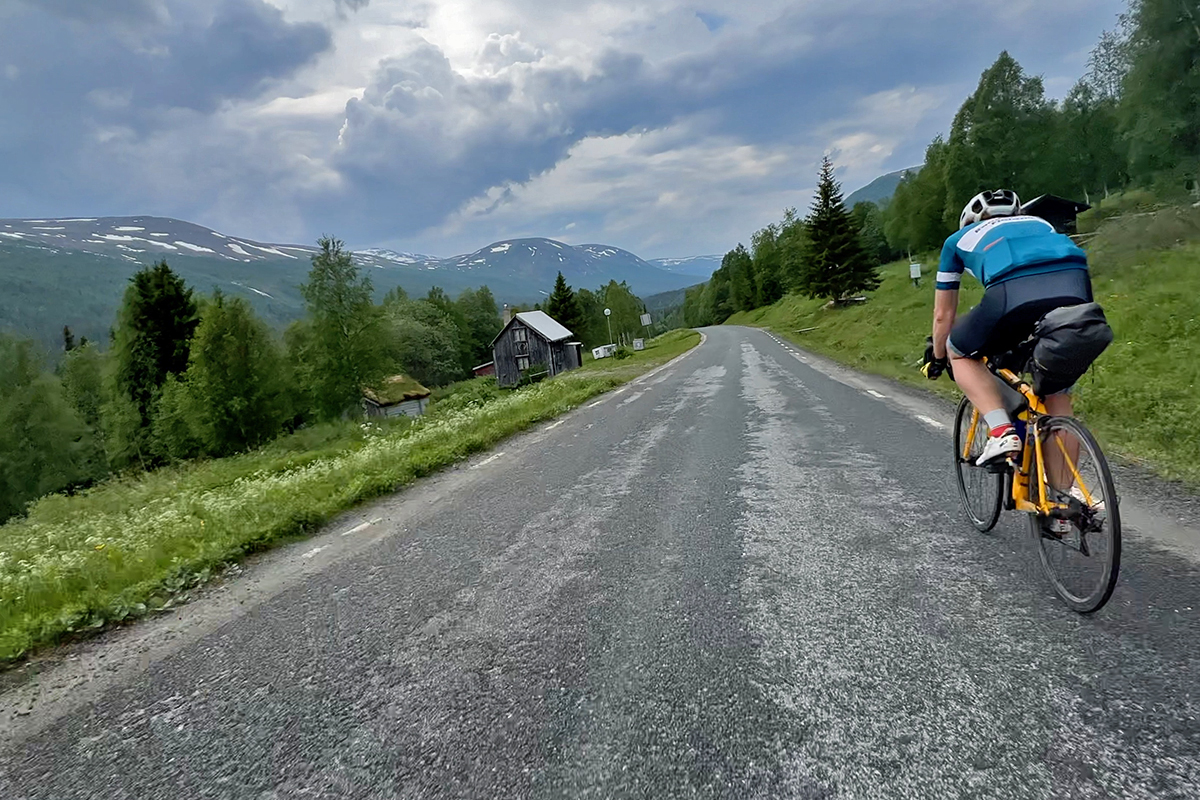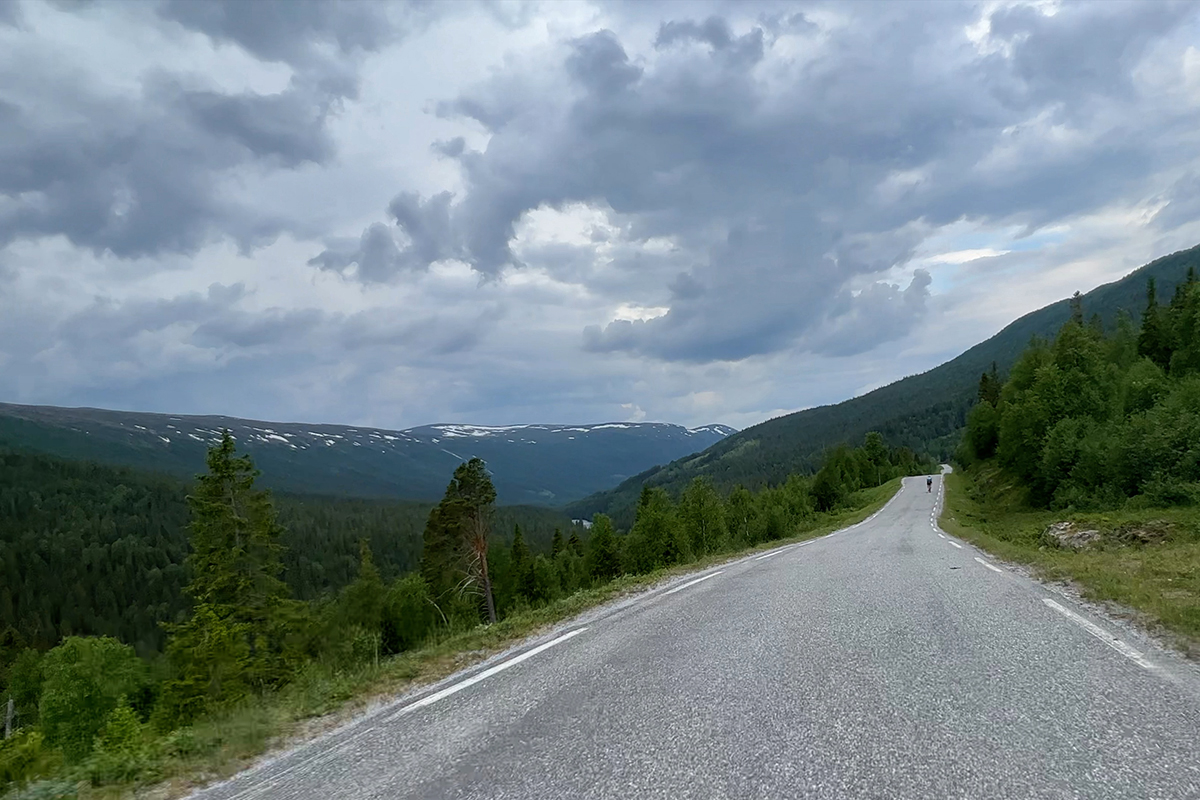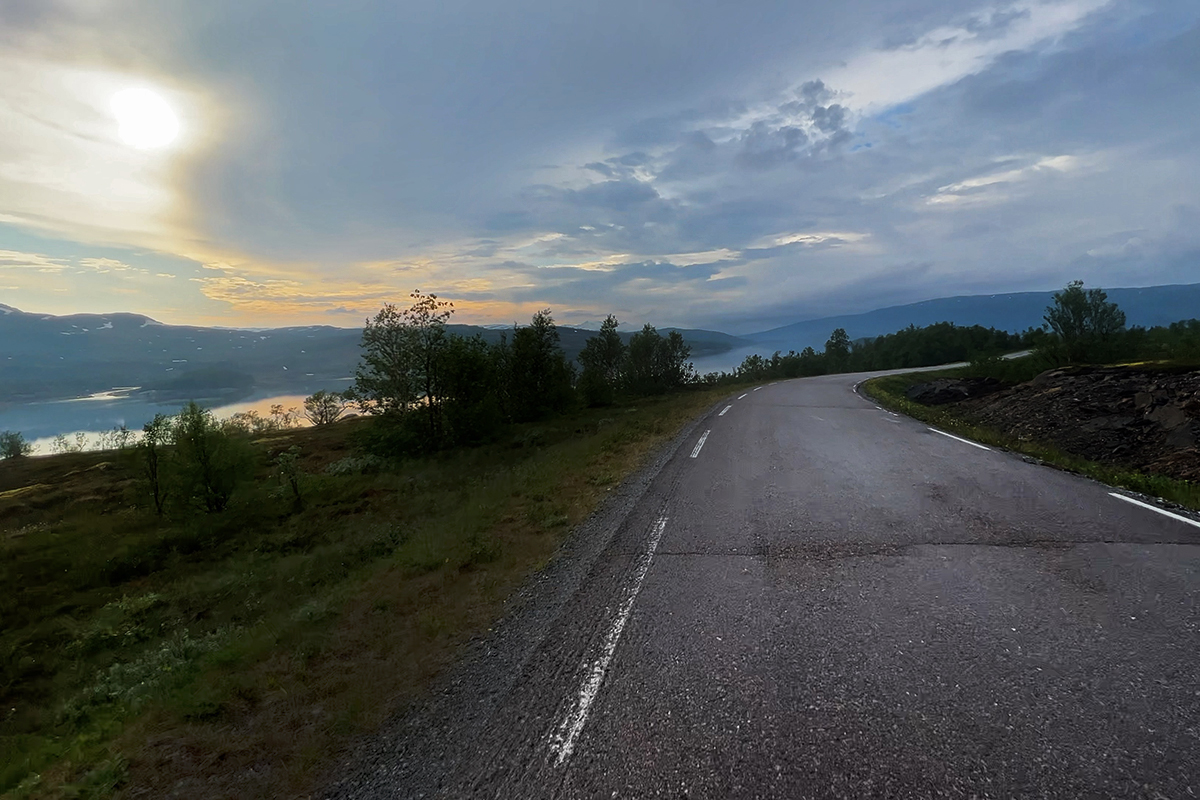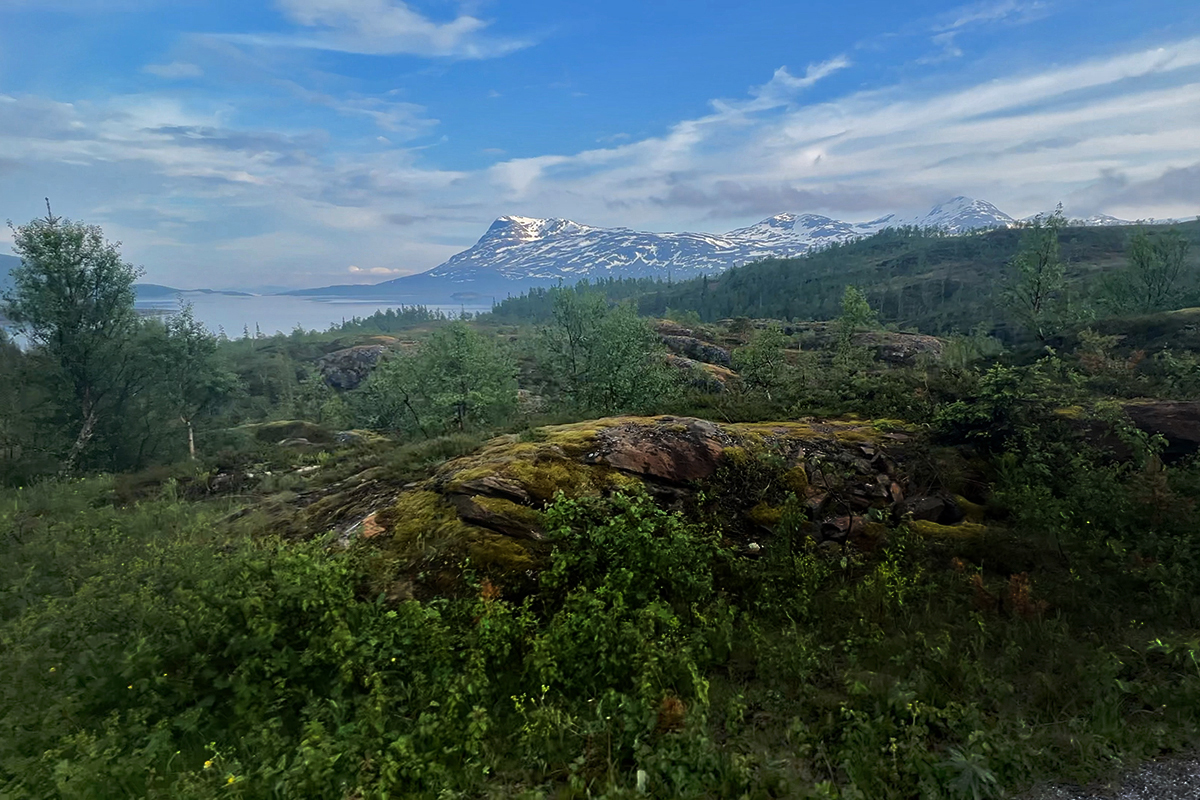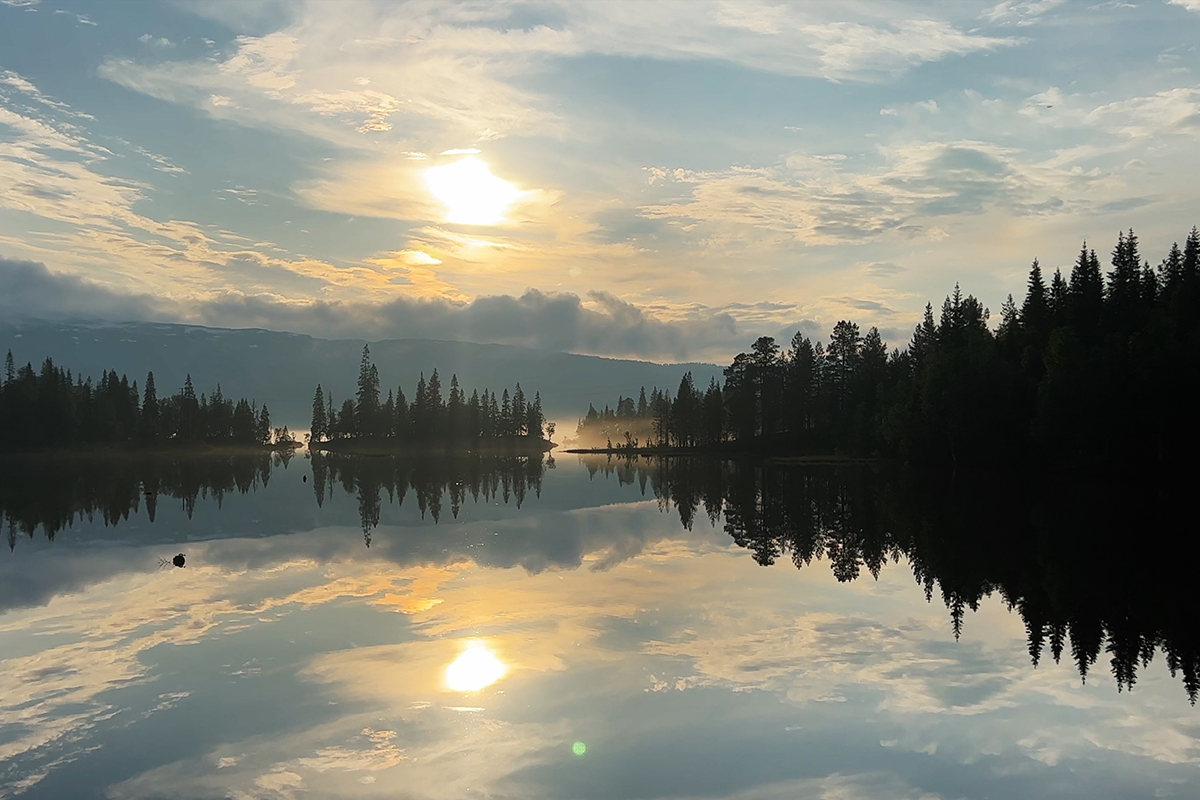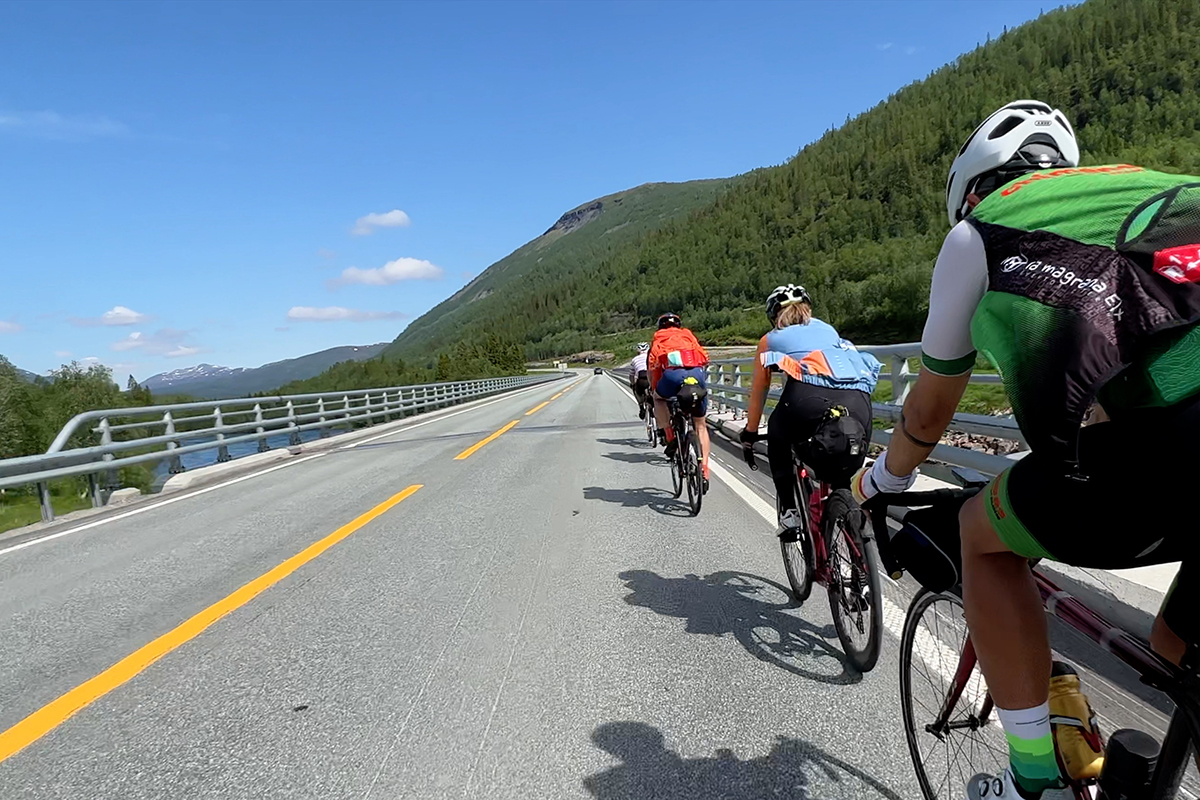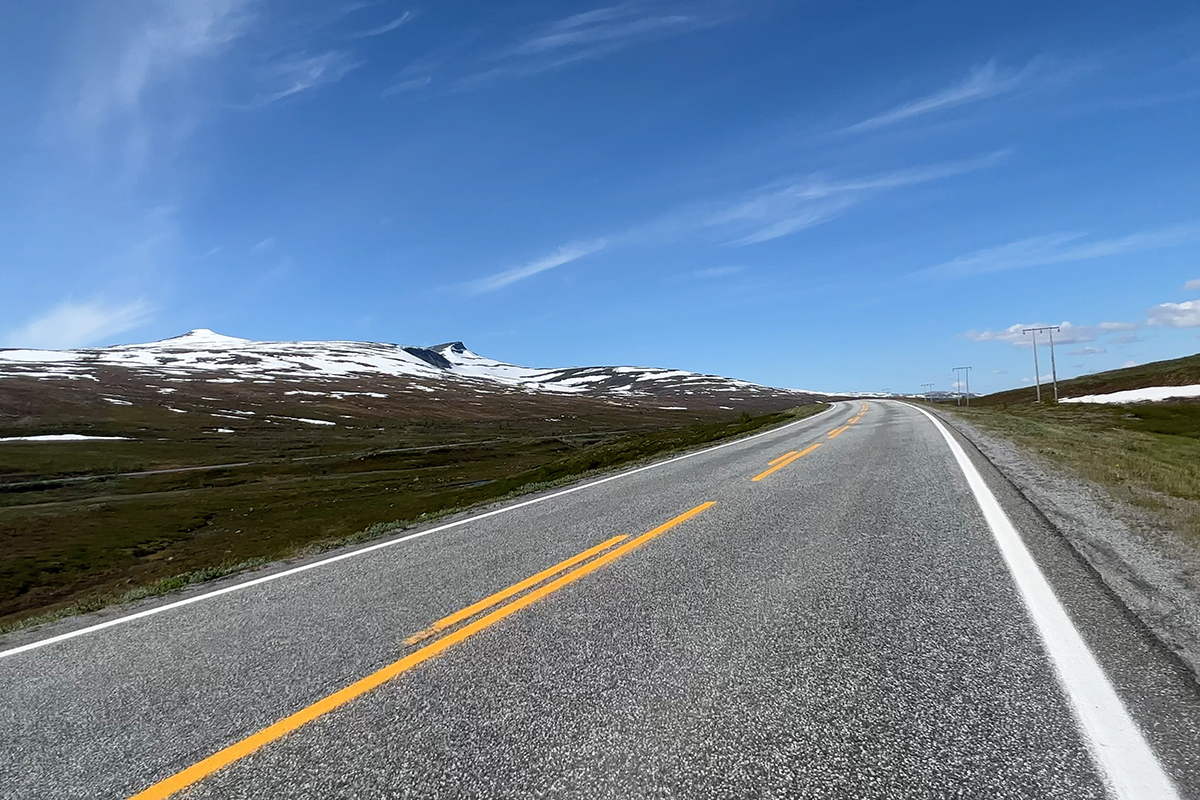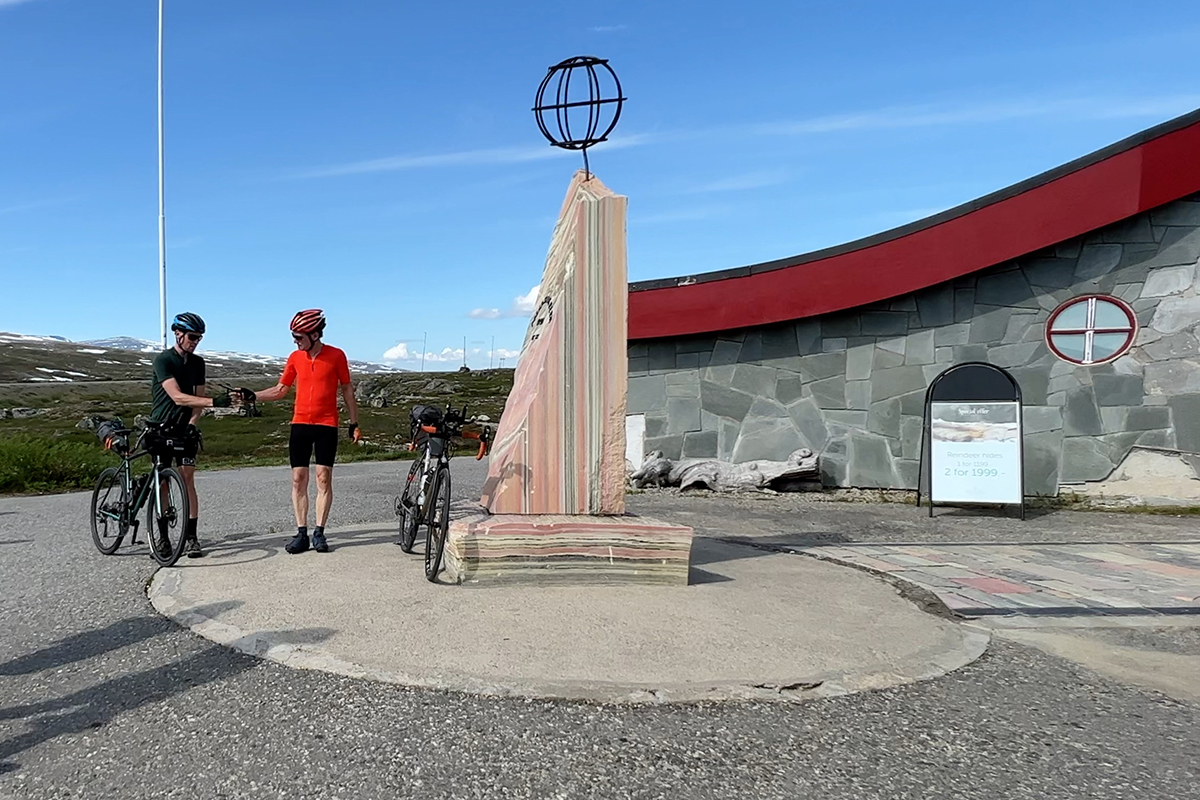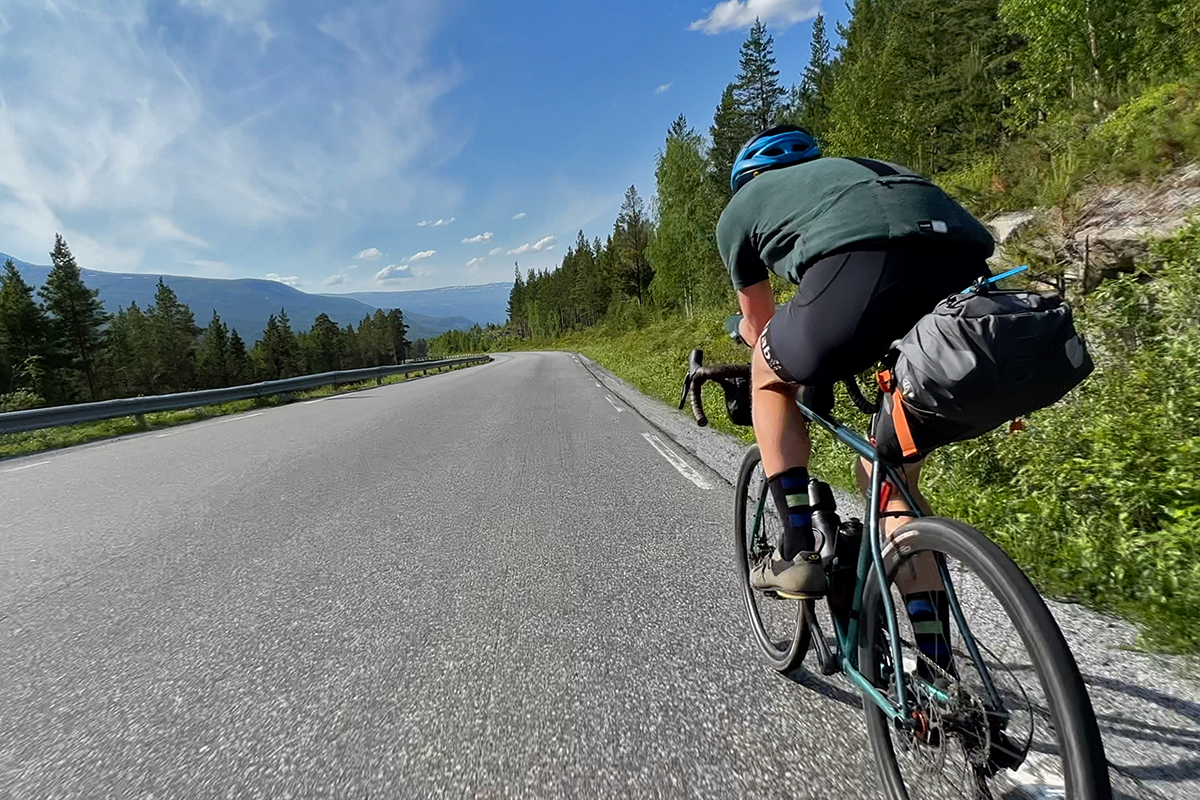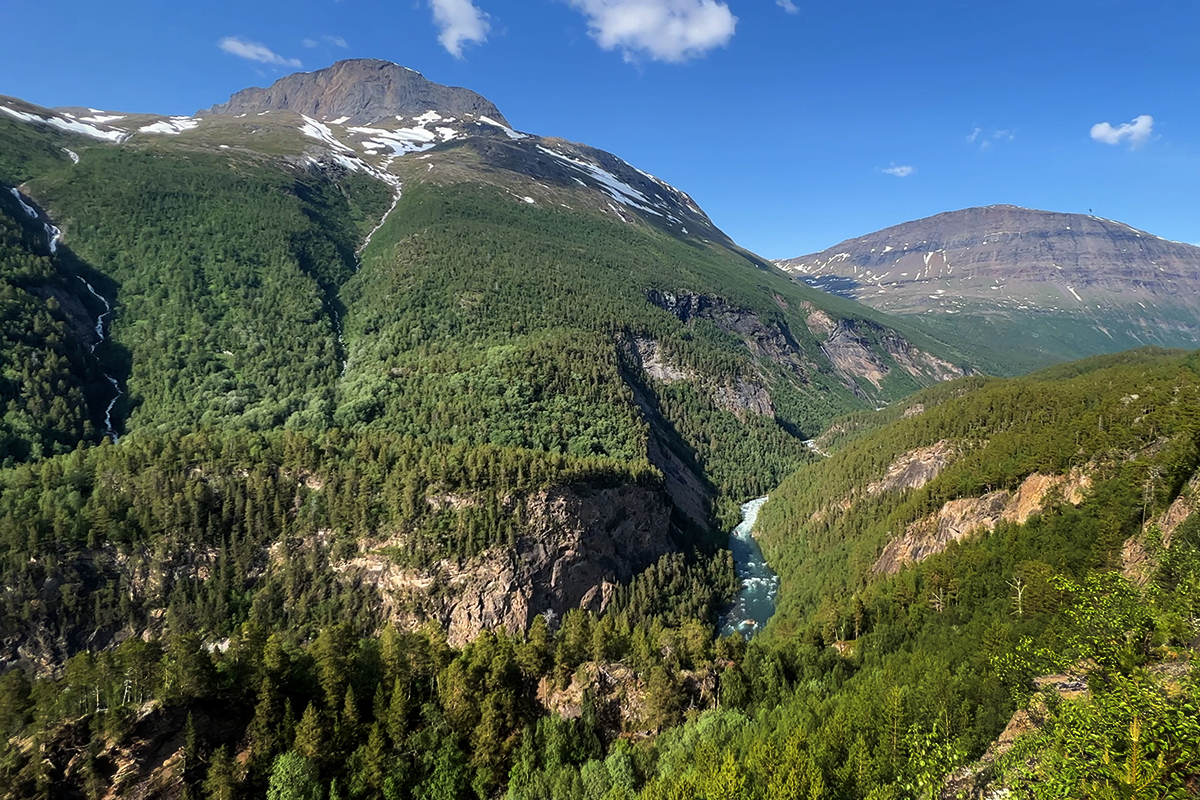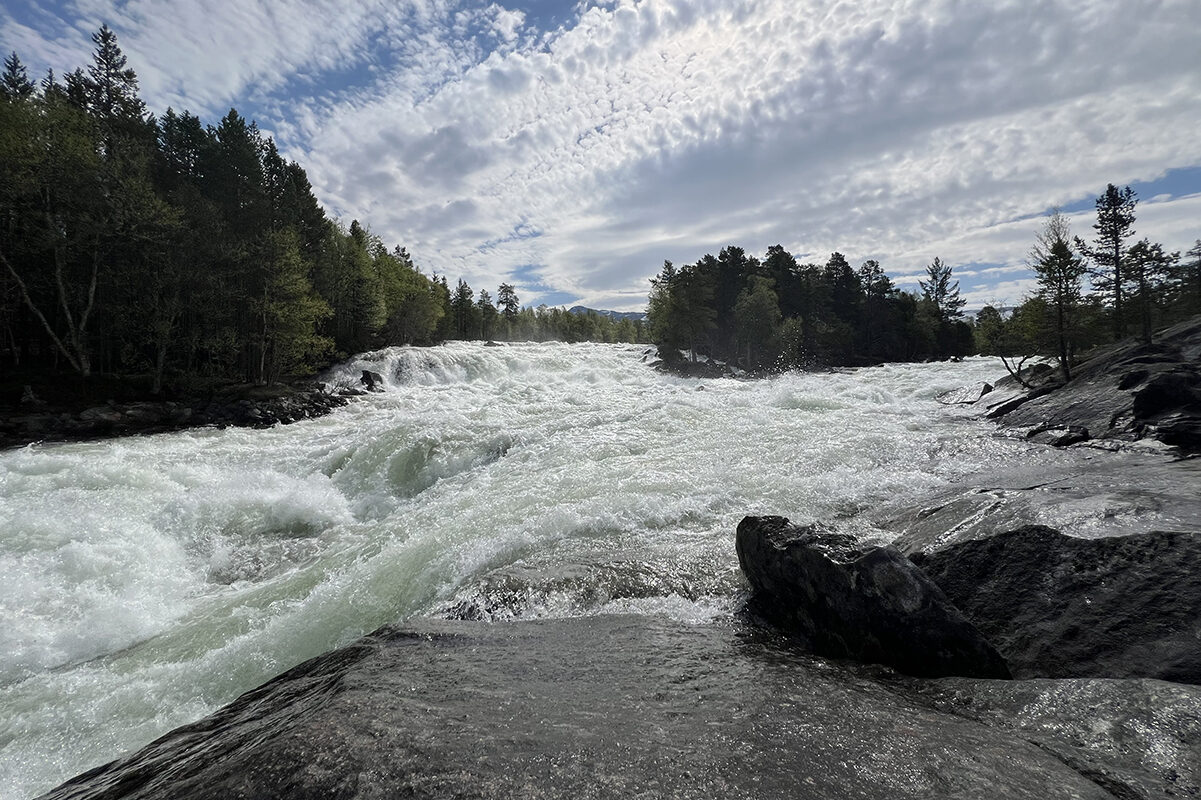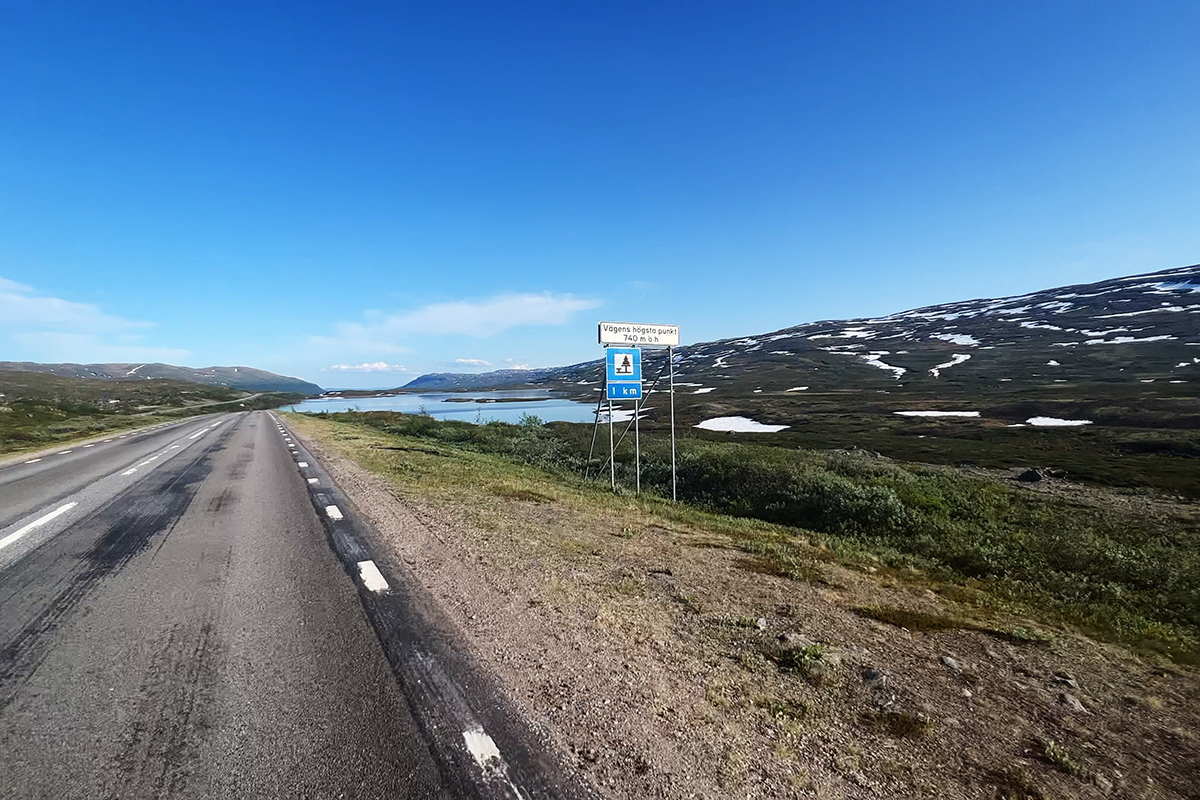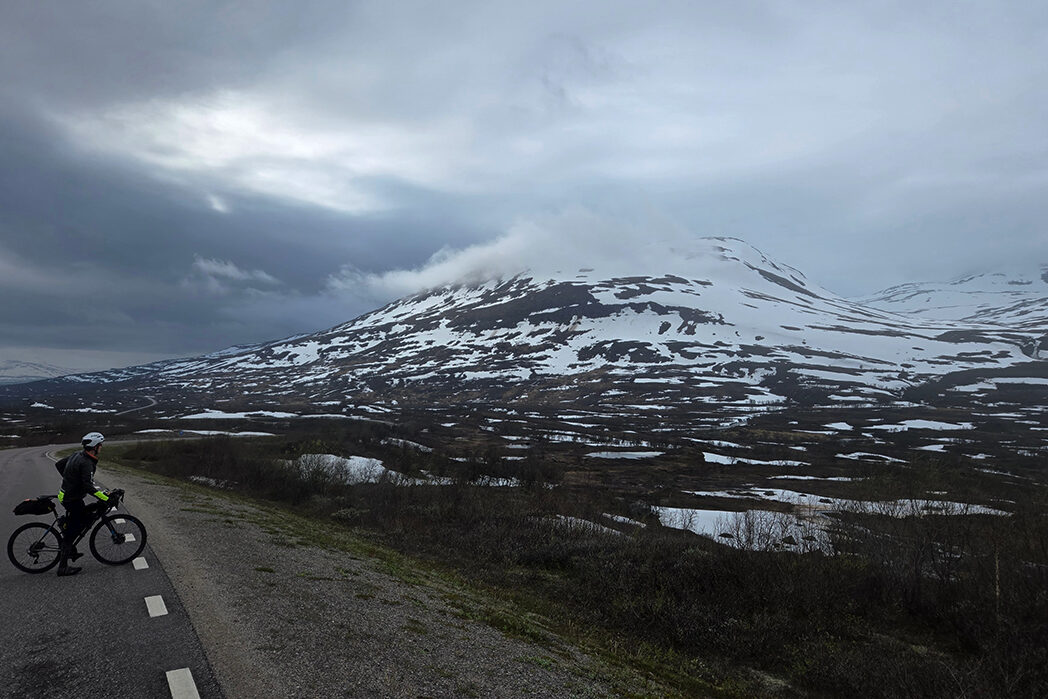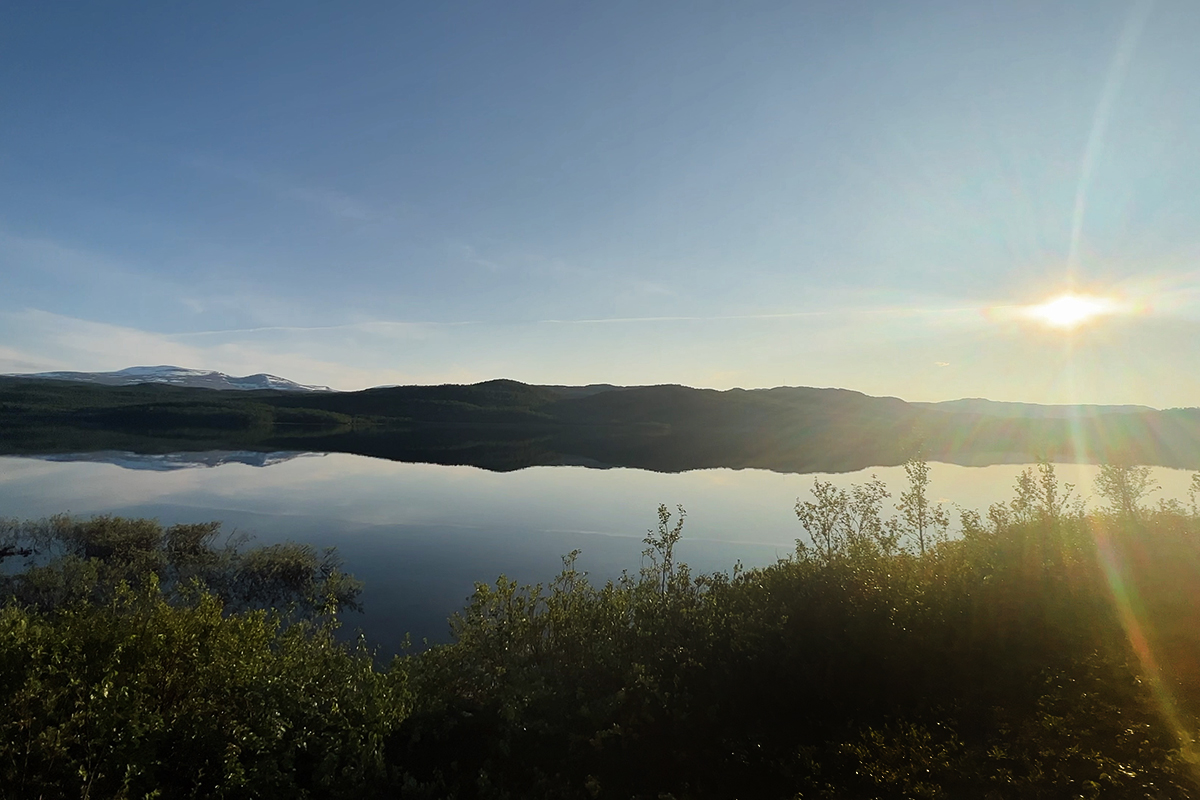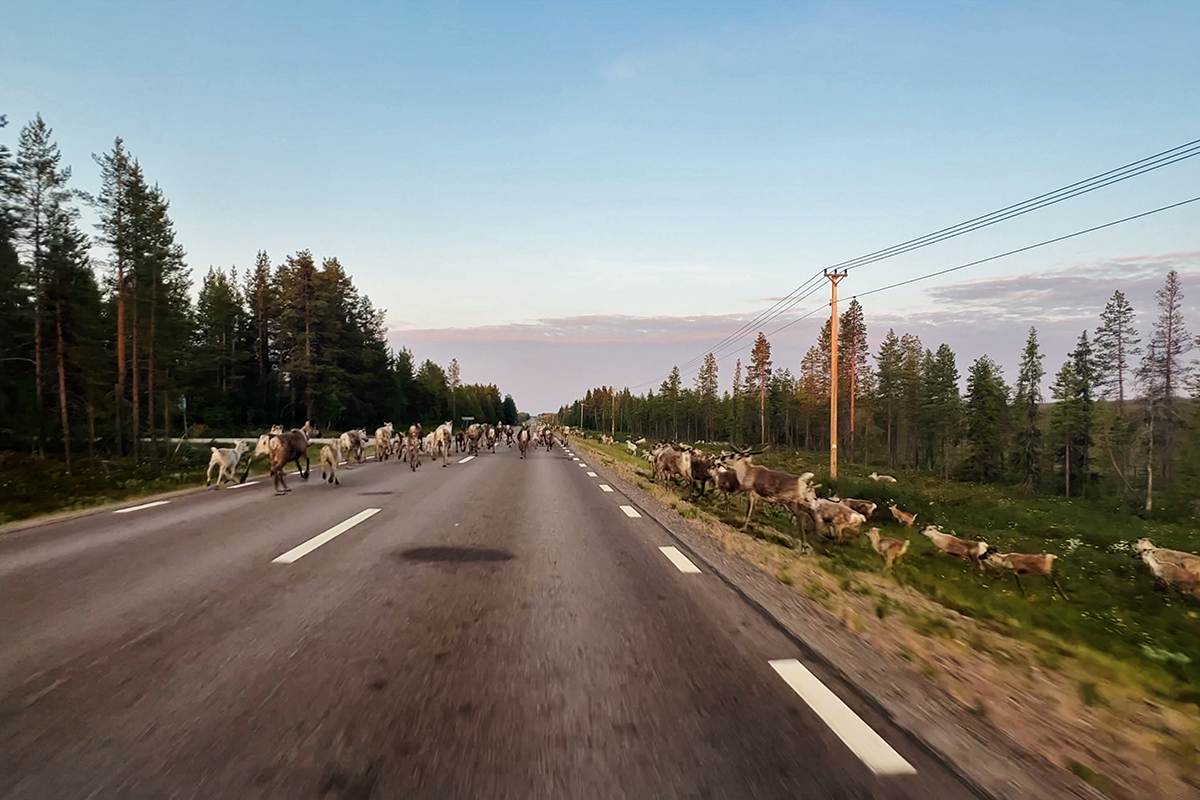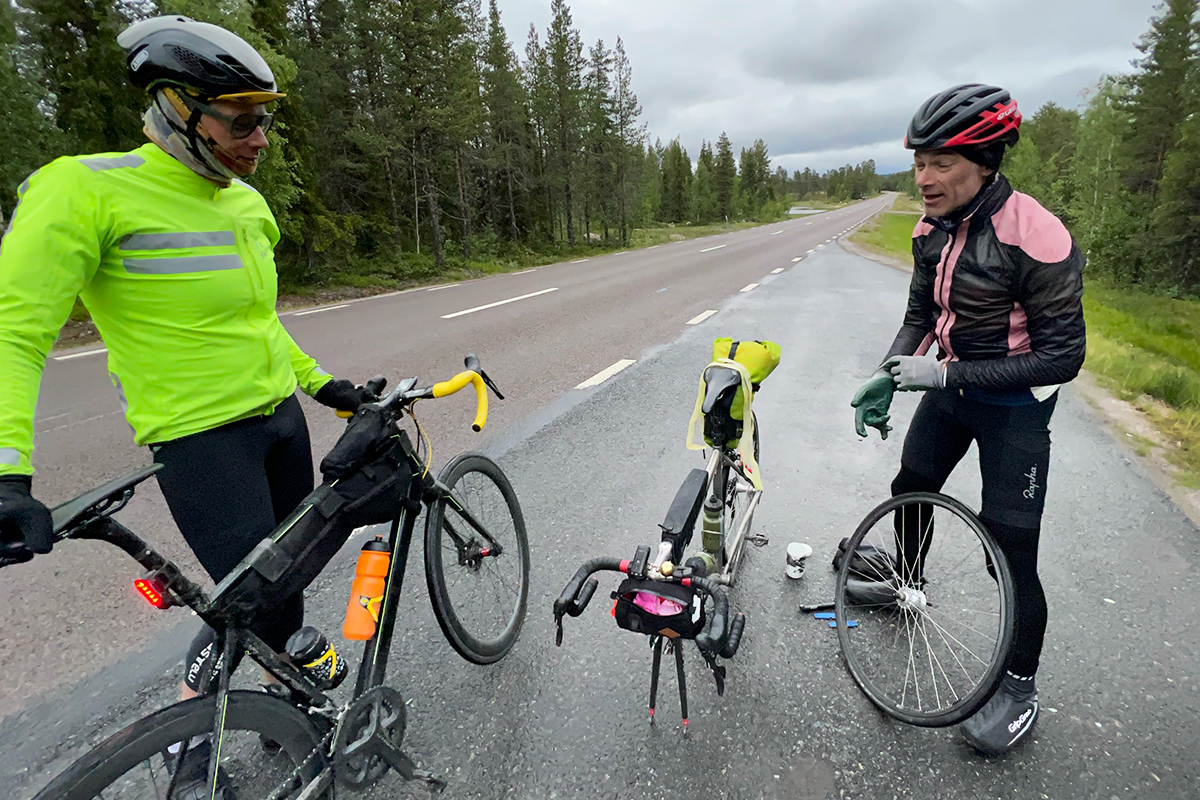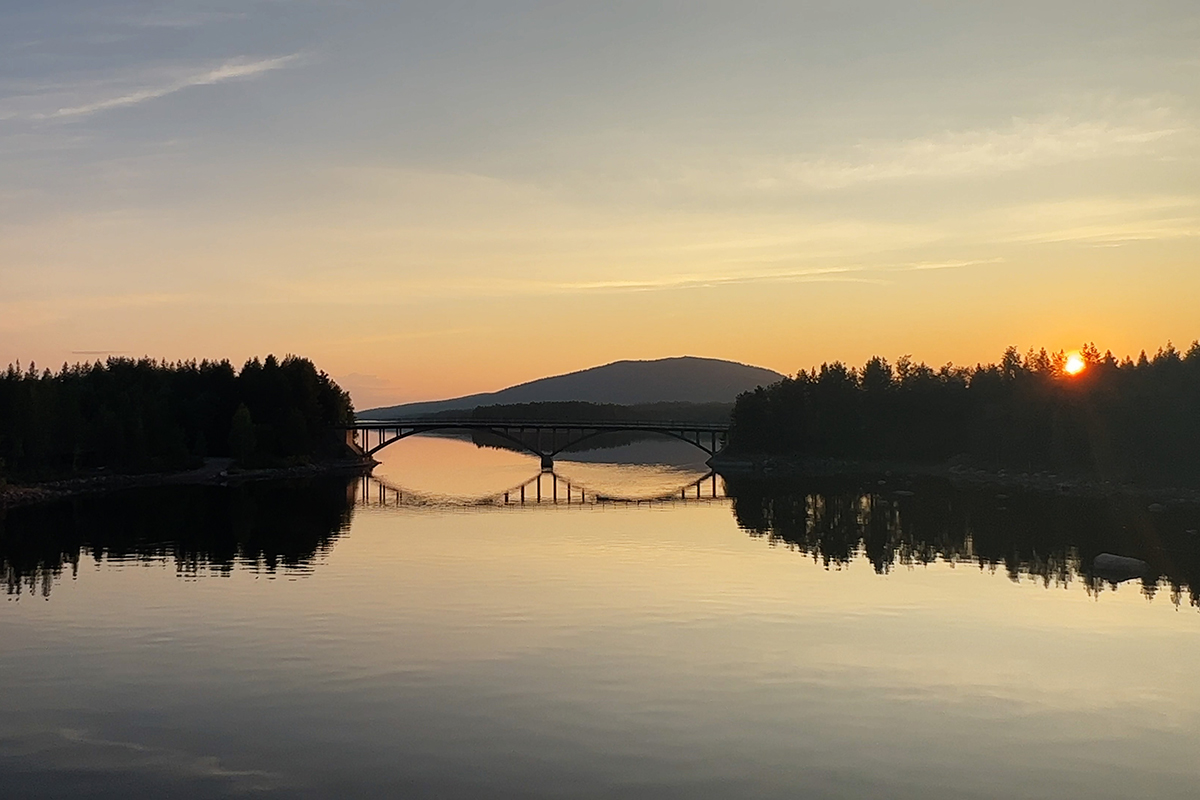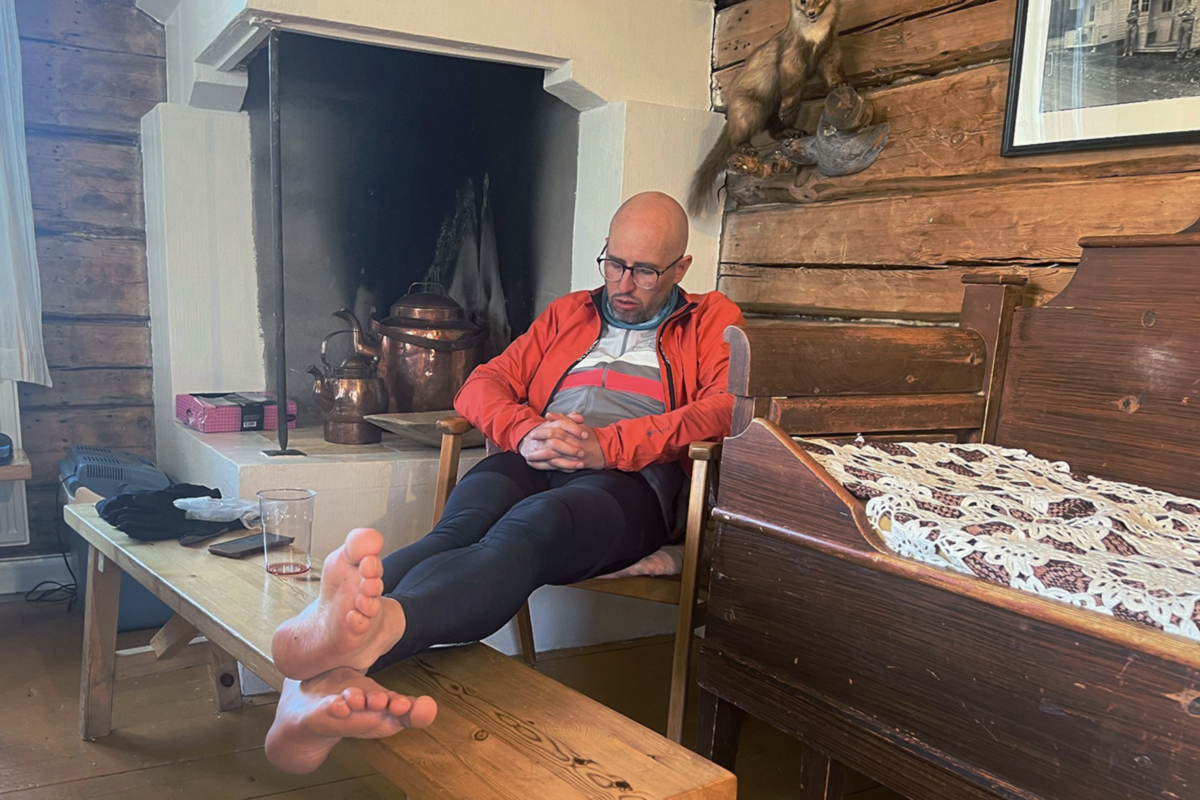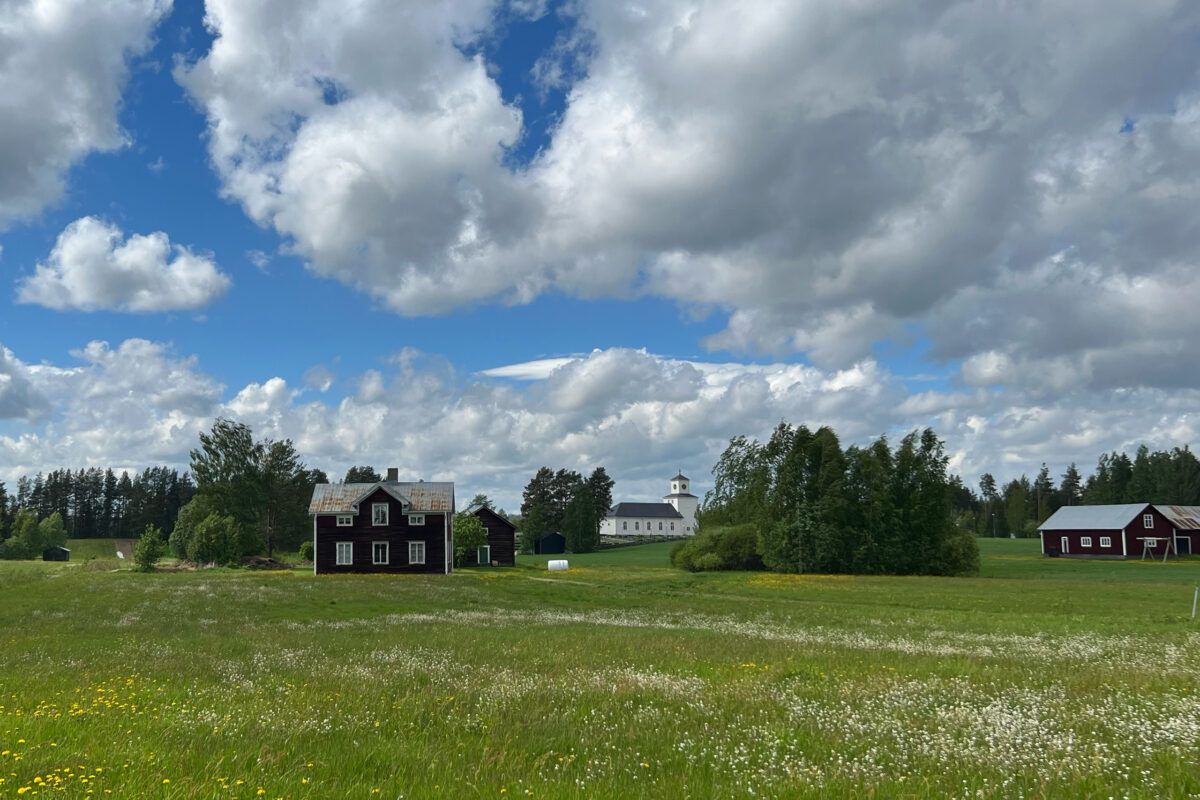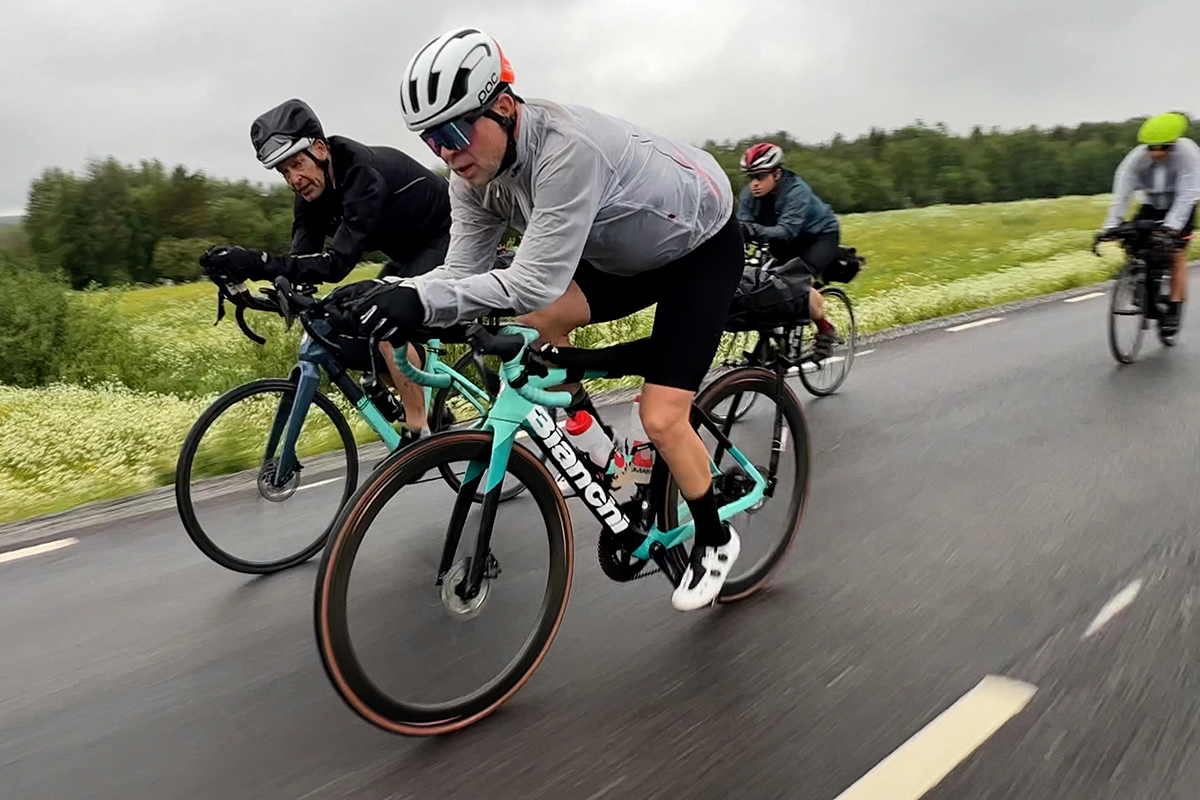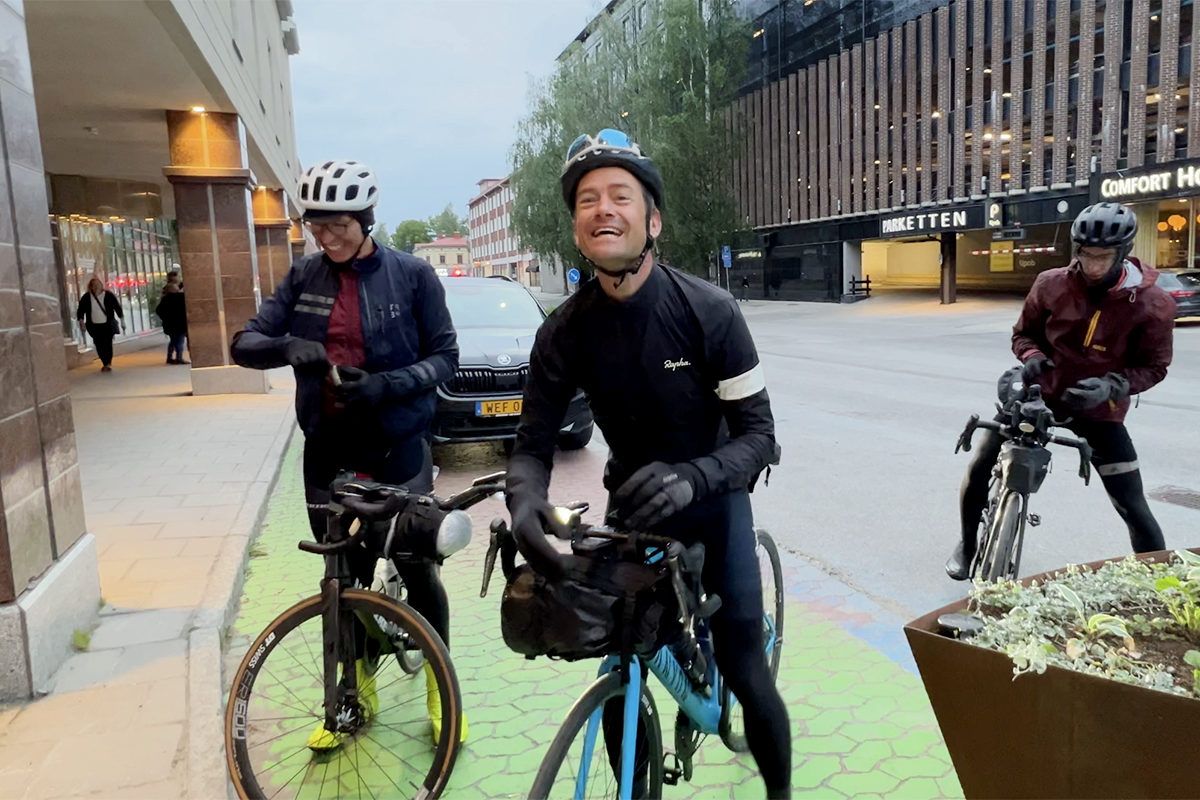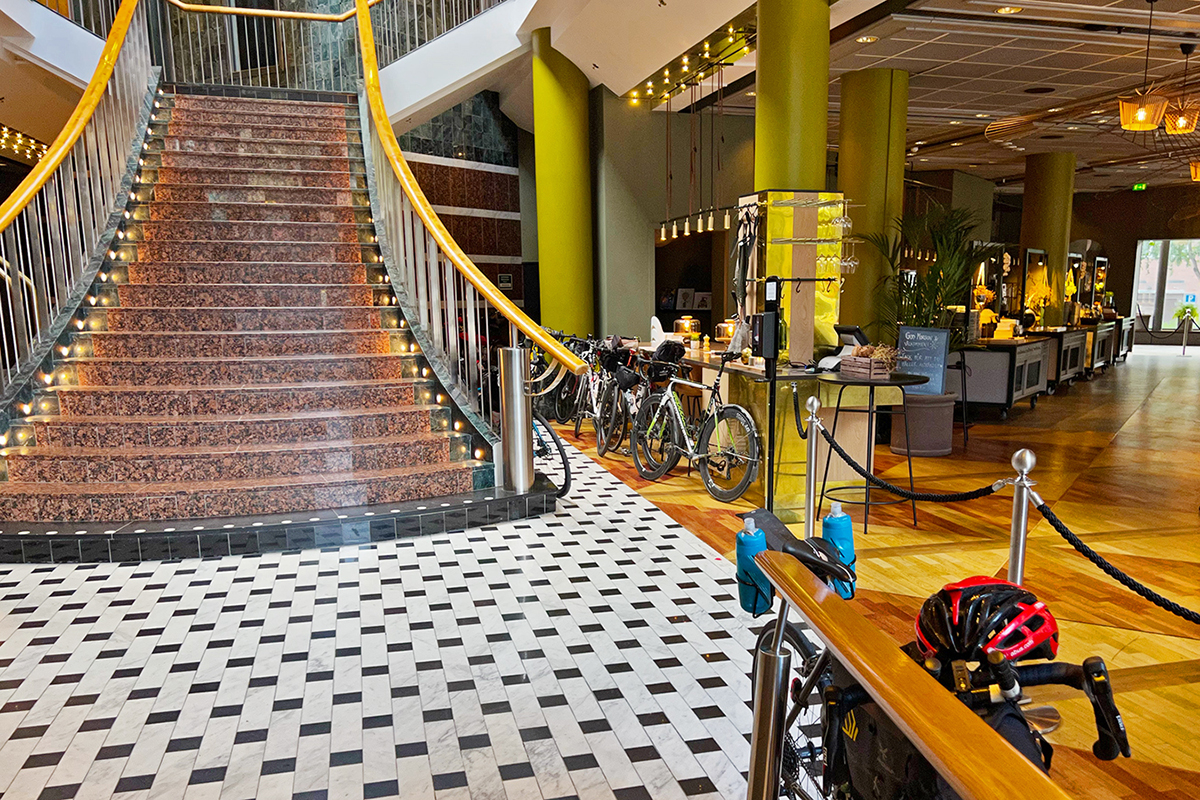Sign up to the fifth edition of Midnight Sun Randonnée, an epic round trip across the Scandinavian peninsula. Follow river valleys, lake shores and fjords. Cross coniferous forests, marshlands, snow-capped mountains and the Arctic Circle. Experience 24-hour daylight conditions during the summer solstice. Book a starting place, then make your final registration at a date of your choosing.
Midnight Sun Randonnée does not require qualification but we recommend that inexperienced riders complete a BRM 400 before the event. We don’t ask for signed medical certificates however, as with grand randonnées in general, we do require that participants have a third-party insurance in case of an accident on the ride.
Course data & Map
Course description
Controls
Accommodation on route
Food & Meals
Status of the roads
Climate & Weather
Clothes & Equipment
Nature & Fauna
FAQ
Course data & Map
Name: Midnight Sun Randonnée
Entry limit: 200 (Start groups)
Start address: Brännland Inn, Brännland 35 Umeå
Finish address: Scandic Plaza Umeå, Storgatan 40 Umeå
Start time: 23:02 – 00:02 CEST
Start date: Sunday 14 June 2026 (end date: Thursday 18 June)
Min.- /Maximum time: 41:21 – 91:08 hours
Number of controls: 11 (+2 secret controls and start/finish)
Controls: Granö, Lycksele, Vilhelmina, Kittelfjäll, Hattfjelldal, Mo i Rana, Arctic Circle, Vuoggatjålme, Arjeplog, Sorsele, Åmsele
Length of course: 1 215 km
Elevation gain: 14 173 m (highest point 740 m a s l)
Course on RideWithGPS: MSR 2026
Course on Komoot: MSR 2026
Email address: info@midnightsunrandonnee.se
Social media: Facebook Group, Facebook Event, Instagram
In case of medical emergency call 113 in Norway and 112 in Sweden.
| CONTROL | KM | (KM) | OPENS | CLOSES | ROUTE | ELEVATION | SERVICE |
|---|---|---|---|---|---|---|---|
| Brännland – Brännlands Inn | 0 | 0 | Sun 14 Jun 23:02 | Mon 15 Jun 00:02 | – | – | Food |
| Granö – Granö Beckasin | 69 | 69 | Mon 15 Jun 01:04 | Mon 15 Jun 03:38 | 01 MSR | 742 | Food |
| Lycksele – Hotel Lappland | 123 | 54 | Mon 15 Jun 02:39 | Mon 15 Jun 07:14 | 02 MSR | 566 | Food |
| Vilhelmina – Hotel Wilhelmina | 241 | 118 | Mon 15 Jun 06:12 | Mon 15 Jun 15:06 | 03 MSR | 2 087 | Food/Sleep |
| Kittelfjäll – Fjälltorget | 370 | 129 | Mon 15 Jun 10:14 | Mon 15 Jun 23:42 | 04 MSR | 1 658 | Food/Sleep |
| Hattfjelldal – Hattfjelldal Hotel | 469 | 99 | Mon 15 Jun 13:28 | Tue 16 Jun 06:18 | 05 MSR | 1 049 | Food/Sleep |
| Mo i Rana – Dalselv Hotel | 569 | 100 | Mon 15 Jun 16:48 | Tue 16 Jun 12:58 | 06 MSR | 1 351 | Food/Sleep |
| Arctic Circle – Arctic Circle Center | 662 | 93 | Mon 15 Jun 20:03 | Tue 16 Jun 20:28 | 07 MSR | 1 574 | Food |
| Vuoggatjålme – Camp Vuoggatjålme | 755 | 93 | Mon 15 Jun 23:22 | Wed 17 Jun 04:36 | 08 MSR | 1 270 | Food/Sleep |
| Arjeplog – Hornavan Hotell | 860 | 105 | Tue 16 Jun 03:07 | Wed 17 Jun 13:47 | 09 MSR | 912 | Food/Sleep |
| Sorsele – Sorsele River Hotel | 951 | 91 | Tue 16 Jun 06:22 | Wed 17 Jun 21:45 | 10 MSR | 741 | Food/Sleep |
| Åmsele – Åmsele Camping | 1 108 | 157 | Tue 16 Jun 12:16 | Thu 18 Jun 10:08 | 11 MSR | 1 324 | Food/Sleep |
| Umeå – Scandic Plaza | 1 215 | 107 | Tue 16 Jun 16:23 | Thu 18 Jun 18:10 | 12 MSR | 1 025 | Food |
Control times calculated according to ACP90 based on course length 1 215 km.
The ride starts an hour before midnight at sunset on Sunday the 14th of June. Cyclists who maintain an average speed of 18-20 km/h including stops will finish between midday and afternoon on Wednesday the 17th of June. Riders maintaining an average speed of 14-16 km/h including stops will finish between early morning and midday on Thursday the 18th of June, the day before Swedish Midsummer’s Eve.
Course description
For rider safety the event starts at sunset 23:02, avoiding heavy traffic on the E12. To reduce the size of the peloton directly after start, and also to shorten the queues at the first control, participants will be divided into starting groups which leave the start location in five minute intervals.
Controls 1-3: The starting point, Brännland Inn (62 m a s l), is located on the outskirts of Umeå about 10 km from the centre. The initial part of the route follows the Ume River and the European highway E12 (also known as Blå vägen, ”The Blue Road”) to the village of Granö where riders cross Ume River on a wooden bridge to reach the first control Granö Beckasin. Making a U-turn back over the river again riders will continue to follow the Ume River all the way to the second control Hotell Lappland in Lycksele (218 m a s l). The sun will already have risen when the first cyclists arrive in Lycksele shortly after 03:00.
From here, the journey leaves the Ume River and the first hilly stage begins on road 360 to Vilhelmina. For the most part the gradients are shallow but the climbs are sometimes long, reaching an altitude of 589 m a s l at the village Risträsk before descending again to Vilhelmina and the brevet’s third control Hotel Wilhelmina. Having completed the first 240 km of the course, cyclists arrive here just in time for breakfast. Hotel Wilhelmina is the first control with organised sleeping arrangements.
Controls 4-5: After Vilhelmina the journey enters the Scandinavian mountain range, the Scandes. Leaving Vilhelmina on the E45 the course soon makes a turn onto road 1067 to the village Stalon. Following the shores of Lake Malgomaj the first half of the stage is reasonably flat until Stalon where the course turns onto road 1077 to the village Dikanäs. Here the first real climb of the stage begins. The road reaches an altitude of 636 m a s l at its highest, crossing through the Marsfjället nature reserve, before descending to the lake Dikasjön (418 m a s l). From here the course continues on road 1088 to the fourth control, Fjälltorget, located in the centre of the village and ski resort Kittelfjäll (535 m a s l).
From Kittelfjäll, the route again crosses through a mostly uninhabited landscape covered with mountain spruce and birch forests, marches, rivers and lakes. The road reaches an altitude of 647 m a s l before crossing the Norwegian border after 61 km. The first cyclists arrive in Hattfjelldal (215 m a s l) and the control Hattfjelldal Hotel around dinner time.
Controls 6-7: Also the stage after Hattfjelldal is hilly albeit with smaller climbs as riders follow the shores of Lake Røssvatnet, Norway’s second largest lake (383 m a s l), on the narrow and winding road 291/331. Watch out for sheep! This road ends with a long shallow descent of almost 25 km down to the village of Korgen where the it connects to the European highway E6. About 7 km after Korgen, the course reaches sea level and, with a view of the Ranfjord, cyclists soon arrive at the sixth control Dalselv Hotell located in the village of Dalselv 11 kilometres before the port city of Mo i Rana (Mo). South of Mo, the speed limit on the E6 is mostly 70 km/h. Between Korgen and Mo there are two short tunnels that cyclists are allowed to cycle through, and also a stretch of road with tunnels after the village Bjerka that cyclists are redirected around (well signposted).
After Mo, participants leave the Ranfjord and the journey continues back into the mountains again on the E6. Just before the village of Røssvoll about 8 km north of Mo, cyclists are redirected around another tunnel (well signposted). About 3 km after Røssvoll there is yet another tunnel that cyclists, on the other hand, can cycle through. It measures 1,3 km and is dimly lit. Bike lights are recommended.
The course then leads the riders through the Dunderland valley, making a short detour down to Rana River and the village of Nevernes and then up above the tree line on Saltfjellet to the seventh control which is the Arctic Circle Center, located at the Arctic Circle. A majority of participants will have passed this control by Tuesday afternoon. Large parts of the highway from Mo to the Arctic Circle Center has been rebuilt and resurfaced in recent years so the road surface is mostly excellent. The climb from sea level up to the Saltfjell highway’s highest point (692 m a s l) is very easy with slope gradients generally between 2-4 percent however a northerly wind, which is not uncommon, may add to the difficulty. Dunderland is sparsely populated so the speed limit north of Mo is mostly 90 km/h.

Please note, during the day the E6 can be very busy with cars, campers and semi-trucks. Most Riders who want to avoid heavy traffic should consider doing these stages late at night (remember; still daylight conditions).
Controls 8-9: After the Arctic Circle Center riders have a long downhill run to Junkerdal where cyclists leave the E6 and begin a 15 km long climb of 600 m on the national road 77/national road 95 up to the Swedish border. The first 2,7 km of the climb have an average gradient of 7,1 percent. Cyclists use the old national road which is closed for motorised traffic for the first section of the climb.
Highway 95 is the only national highway (A-road) that crosses the Scandes above the tree line and about 8 km after the border the course reaches its highest point at 740 m above sea level. From here, the journey continues down to SMHI’s (Swedish Meteorological and Hydrological Institute) weather station in Mierkenis and then further on to Lake Vuoggatjålmjaure (481 m a s l) and Camp Vuoggatjålme, which is the brevet’s eighth checkpoint. Here, we are still north of the Arctic Circle so the sun will stay above the horizon all night. After Ust’-Shchuger in Russia, the second coldest temperature in Europe has been registered in Vuoggatjålme: -52,6°C.
The stage to Vuoggatjålme is the last of the hilly stages. From Camp Vuoggatjålme the course continues down to Arjeplog and the ninth control Hornavan Hotel, located on the Lake Hornavan (426 m a s l) which is Swedens deepest lake with a depth of 221 m. Participants aiming for a finishing time of around 75 hours will arrive here well after midnight on Wednesday. The fastest cyclists, aiming for a finishing time around 60 hours, will have arrived here around dinner time on Tuesday.
Although also Vuoggatjålme has bus connections, Arjeplog is the control where most riders abandon the brevet and take the bus back to Umeå. If you abandon in Arjeplog, take time to visit the famous Silver Museum which is well worth a visit.
Controls 10-11: After Arjeplog, the journey heads south east on straight or gently curving roads through flat and forested landscapes. Stronger riders may use these last stages to make up time after the hilly stages whilst riders with tired legs may find the endless forests mentally challenging, especially if it is raining or there is a headwind, or both.
Road 609 from Arjeplog leads to Slagnäs where the course reconnects with the European highway 45 (the Inland Road) and from Slagnäs participants then follow the Inland Road to Sorsele and the tenth checkpoint which is Sorsele River Hotel.
From Sorsele, the journey continues 28 km on the Inland Road before turning onto road 363 which follows the Vindel River. This river is an unregulated tributary to Ume River which has it source in Vindelfjällen. Vindelfjällen Nature Reserve is one of the largest protected areas in Europe.
Road 363 leads down to the brevet’s eleventh and final control which is Åmsele Camping in Åmsele. This is the last control with organised sleeping arrangements. From Åmsele, the journey continues past the villages Hällnäs and Vindeln on road 363, Sweden’s longest county road, to the village Tavelsjö via a short detour through the village of Rödåsel.
After Tavelsjö the course leaves the 363 and turns onto road 629 which leads to the village of Kassjö and later also the start location in Brännland. From there riders follow familiar town roads down to the end control: Hotel Scandic Plaza Umeå.
Controls
The event provides sleeping arrangements at most controls for short naps. Blankets and towels for showers are provided by the facilities. Please note, these sleeping arrangements are limited and are not secluded. If you feel that you will need deep sleep during the ride we recommend that you book a private room or cabin where you can sleep between sheets. Rooms and cabins can be booked in advance or subject to availability upon arrival during the ride. See booking details below.
The first control is Granö Beckasin on Ume River. Here cyclists make a quick stop for refreshments. The second control is Hotell Lappland in Lycksele where cyclists will arrive a few hours after sunrise. Here participants will make a longer stop to eat a proper meal. The brevet’s third control, Hotel Wilhelmina in Vilhelmina, is the first control with sleeping arrangements for short naps. Obviously, private hotel rooms for longer naps can be booked here also. Kittelfjäll is the fourth control. Here, there are several 4-bed rooms at Kittelfjäll Youth Hostel which also has showers and a kitchen.
Hattfjelldal Hotel is the first control in Norway. It also has non-secluded sleeping arrangements for short naps and also a shower. Many cyclists book private accommodation here so be sure to book a hotel room well in advance if you are planning to sleep here! The next control is Dalselv Hotell and also here the event has organised arrangements for shorter naps. This hotel is too small to accommodate private bookings so riders who plan to sleep at this control are recommended to continue on to the town Mo i Rana where there are multiple hotels. Mo i Rana also has a 24-hours petrol station, restaurants, cafés and grocery stores.
From Mo the course leads up onto Saltfjellet to the Arctic Circle and the Arctic Circle Center where riders make a food stop. The last place to sleep between controls before the Arctic Circle is the guesthouse Krokstrand Café & Rooms in Krokstranda (private accommodation). Coming down from Saltfjell, the course leaves the E6 at Junkerdal where it turns east and heads back to Sweden. If you continue straight ahead 1 km from here you will find another alternative for private accommodation: Saltdal Turistsenter. In addition to motel rooms and cabins Saltdal Turistsenter also has a grocery store and a restaurant.
After Junkerdal and the Swedish border comes the brevet’s eighth control Camp Vuoggatjålme on Lake Vuoggatjålmjaure. Here participants have a number of cabins at their disposal and also a variety of cabins that can be booked privately. Larger groups can for instance book chalets with private saunas. Vuoggatjålme has a restaurant and bar situated by the lake and also showers and a sauna in the event of bad weather.
The ninth control is Hornavan Hotel in Arjeplog. Also here there are non-secluded sleeping arrangements for participants and also showers and a sauna in case of rain. In addition to the included meal, hungry participants can also buy a ticket for a breakfast buffet between 06:30 and 09:00. Also Hornavan Hotel is very popular so be sure to book a room well in advance if you plan to sleep here. The tenth control with organised sleeping arrangements is Sorsele River Hotel in Sorsele. This control also offers a shower and sauna in case of bad weather.
The brevet’s eleventh and last control before the finishing line is Åmsele Camping in Åmsele. Here too there are sleeping arrangements and cabins can also be rented privately. Riders finishing over 80 hours tend to make a their third longer stop here.
At the finish line at Scandic Plaza, all participants will receive a lunch box at the reception upon arrival. Participants who complete the ride will have their brevet cards stamped at the reception and will then receive a medal. If you have booked a room at the hotel and are experiencing muscle soreness after the ride, the hotel’s sauna on the 14th floor, spectacular views of the countryside around Umeå, is well worth a visit.
Accommodation on route
Hotel rooms and cabins can be booked privately on location or in advance if you want to take longer breaks during the brevet. Please check the links below to hotels and campsites with cabins. Some offer discounts to participants.
Vilhelmina – Hotel Wilhelmina
Book a room on website Wilhelmina Hotel or call +46 940-554 20.
Kittelfjäll – Kittelfjäll Hostel
Book a room on website Kittelfjäll Hostel or call +46 70 277 15 14.
Hattfjelldal – Hattfjelldal Hotel
Book a room on website Hattfjelldal Hotel/GoExtreme or send email to: even@goextreme.no or call +47 916 84 340.
Mo i Rana – Thon Partner Hotel
Book a room on website Thon Partner Hotel or call +47 21 49 69 00.
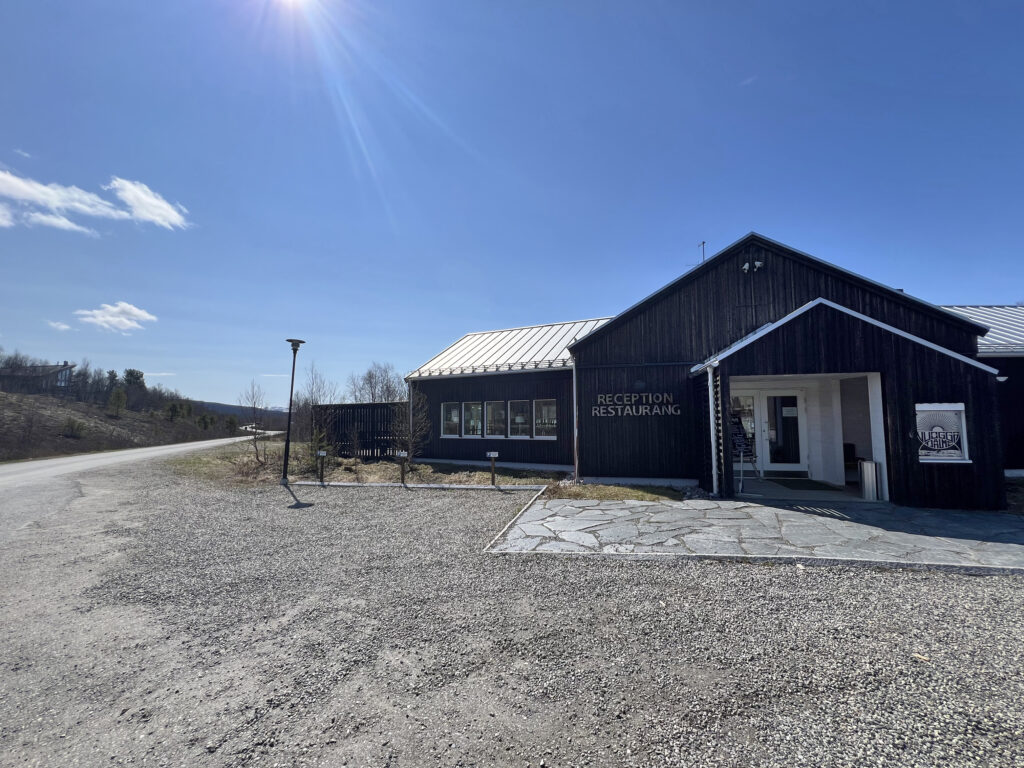
Vuoggatjålme – Camp Vuoggatjålme
Book a cabin online at Camp Vuoggatjålme, send an email to info@vuoggatjalme.se or call +46 961-107 15.
Arjeplog – Hornavan Hotel
Book a room at Hornavan Hotel by email info@hornavanhotell.se or call +46 961 777 100. For 10% discount on booking, use discount code MIDNIGHTSUN.
Sorsele – Sorsele River Hotel
Book a room at Sorsele River Hotel by email info@sorseleriverhotel.se or call +46 952-121 50. For 10% discount on booking, use discount code MIDNIGHTSUN.
Åmsele – Åmsele Camping
Book a cabin at Åmsele Camping by sending an e-mail to amselecamping@gmail.com or call +46 72 274 04 64.
Food & Meals
The menu for 2026 will be set during the spring but it will be similar to previous years. The menus at most, but not all controls, have local or national influences and are made from local ingredients. For lunch at Brännland Inn on the start day, riders are served the Austrian dish Kaiserschmarrn (scrambled pancakes). Later in the evening, riders are served a light buffet dinner before sign-in at 20:00.
At the control in Granö riders made a quick stop for coffee and an energy ball made from dates, blueberries, oatmeal and chocolate. The first food control in Lycksele has a breakfast buffet where participants can make their own sandwiches. Also the second control, Hotel Wilhelmina, has a breakfast buffet. The third control in Kittelfjäll has a lunch buffet with a choice between three freshly made dishes. At the fourth control, Hotel Hattfjelldal, a Norwegian speciality is served: arctic char soup served with a focaccia bread, followed by coffee and cookies. The fifth control in Mo i Rana may serve a salmon wrap. The sixth control, Arctic Circle Center, will be serving waffles with strawberry jam and cream together with a reindeer meat wrap followed by coffee. At the seventh control in Vuoaggatjålme riders are served a pasta salad with chicken. In Arjeplog, Hotel Hornavan may be serving meatballs of moose meat together with a potato salad. Sorsele River Hotel, the eighth control, offers a few different dishes. In Åmsele participants are treated to the local dish, Palt, which is fried over an open fire and served with lingonberries and butter, followed by coffee. Finally at the end control Hotel Plaza Umeå riders are served a creamy potato salad.
At all controls there are options for vegans and vegetarians. When registering to the event please submit special food requirements: vegan or vegetarian, food allergies, lactose or gluten intolerance etc.
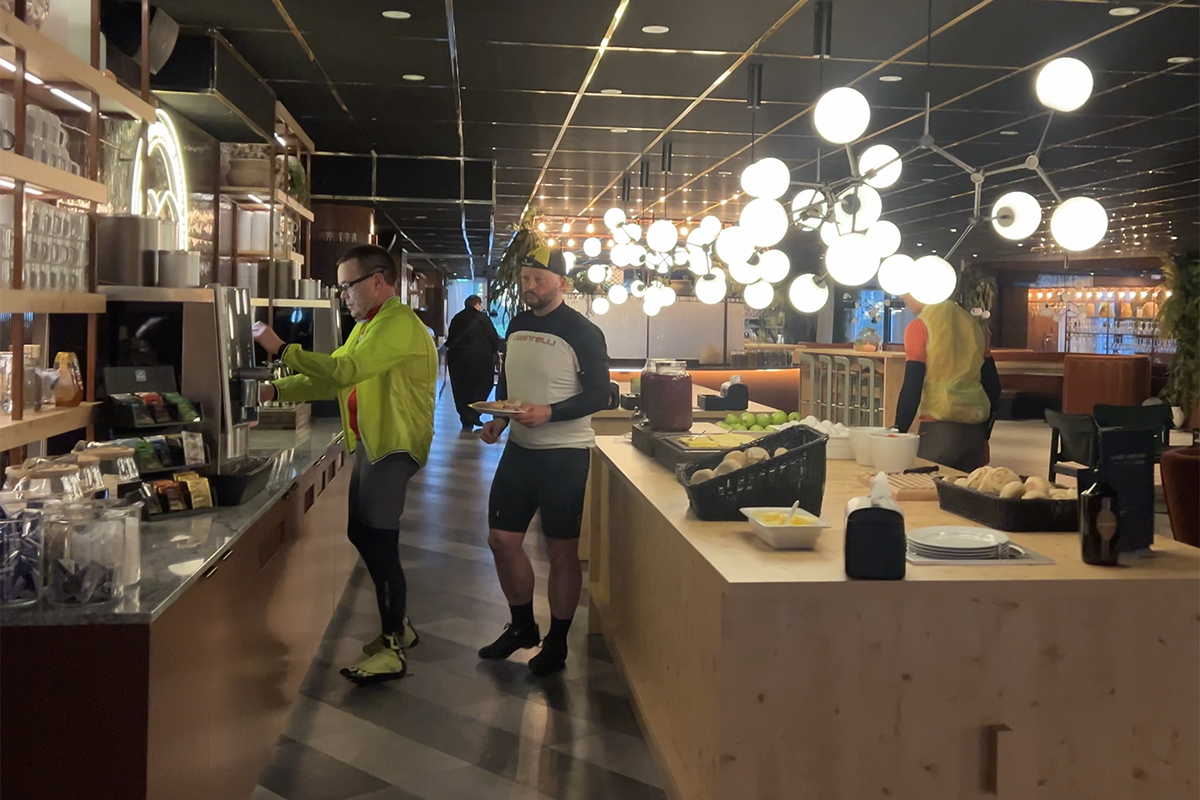
Grocery stores & Restaurants
This event takes place in a sparsely populated region of Scandinavia so towns and villages are few and far between. The opportunities for spontaneous stops between controls to refill supplies are therefore very limited. That said, most towns and villages where controls are located have grocery stores, and in some cases also restaurants. Grocery stores in smaller villages usually close at 18:00. Some villages where controls aren’t located also have grocery stores, restaurants and petrol stations which serve fast food.
On route, the towns Lycksele and Mo i Rana have Circle K petrol stations which are open 24 hours. In Vilhelmina the OKQ8 petrol station is open from 06:00 and the local Coop opens at 08:00. Between Vilhelmina and Kittelfjäll the village Stalon has petrol station with a small food store and Dikanäs has a Coop which is open until 18:00. Also Kittelfjäll has a Coop open until 18:00. Hattfjelldal has a Coop Prix which is open until 20:00. In the village Korgen, between the controls Hattfjelldal and Mo i Rana, there’s a Circle K petrol station which serves fast food and is open until 22:00. Between Mo i Rana and the Arctic Circle Center there’s a Coop Prix in the village of Storforshei open from 08:00 to 22:00.
A few kilometres before Vuoggatjålme riders will find a food store at Sandviken Mountain Lodge on Lake Tjaktjaure. Approximately 3 kilometres after Vuoggatjålme there is another food store at Camp Polcirkeln. In the village Jäkkvik, the grocery store ICA Nära, which also has a café, is open from 09:00 and 20:00. In Arjeplog, Coop is open from 07:00 to 22:00 and Coop in Sorsele is open from 08:00 to 20:00. In Rusksele, between the controls Sorsele and Åmsele, the grocery store Handlar’n is open between 10:00 and 18:00. As is also the Handlar’n in Åmsele. The Coop in Vindeln between Åmsele and Umeå is open from 08:00 to 21:00. Vindeln also has a few restaurants and cafés.
All establishments in Sweden and Norway accept debit cards such as Mastercard and VISA; also in combination with Apple Pay for contactless payments. Participants do not need to carry cash during the ride.
Status of the roads
Please note, the 2026 edition of MSR will not contain a gravel section. Excepting road works, the event will be held on paved roads that are for the most part in acceptable or excellent condition. Some roads are paved with rough and grippy chip-seal others with a smoother asphalt. Sections of the mountain roads, especially in Norway, are frost-damaged with ravelled asphalt and transverse cracking of the road surface. Look out for potholes and ruts on those roads. Larger tire dimensions and low tire pressures will reduce road vibrations but for the course as a whole regular tires with dimensions 25-28 mm are sufficient.

After Vännäsby, 22 km from the start location, riders will turn onto the E12 where it is a three lane section of 1 km with the single lane leading in the direction of the course. Please avoid riding in a group here as it will be difficult for traffic to overtake. Cycle in single file until you reach the intersection 92/E12 where you turn right to Lycksele.
Climate & Weather
The meteorological definition of spring is rising daily average temperatures between 0°C and 10°C for at least seven consecutive days. At the latitudes of the event, meteorological spring normally occurs in late April and early May. Meteorological summer occurs when the daily average temperature has been at least 10°C during five consecutive days. In the mountains, meteorological spring turns into meteorological summer during the event in mid-June.
The daytime temperatures on lowland terrain will be around 15 – 20°C which will drop to 10 – 5°C at altitudes above the tree line. Night temperatures on low-lying terrain: 10 – 5°C. Above the tree line, night temperatures stay around 5 – 0°C.
| CONTROL | DAY-NORMAL | DAY-MAX | NIGHT-NORMAL | NIGHT-MIN. | WIND-AVG. | WIND-MAX |
|---|---|---|---|---|---|---|
| Umeå | 20°C | 24°C | 8°C | 4°C | ||
| Lycksele | 20°C | 26°C | 7°C | 2°C | ||
| Storuman | 19°C | 25°C | 7°C | 2°C | ||
| Kittelfjäll | 14°C | 22°C | 4°C | -1°C | 7 – 14 km/h | 32 km/h |
| Hattfjelldal | 12°C | 23°C | 6°C | 2°C | 7 – 14 km/h | 32 km/h |
| Mo i Rana | 17°C | 26°C | 10°C | 4°C | 7 – 14 km/h | 32 km/h |
| Arctic Circle | 9°C | 23°C | 6°C | 2°C | 11 – 18 km/h | 32 km/h |
| Vuoggatjålme | 14°C | 22°C | 4°C | -1°C | 7 – 21 km/h | 50 km/h |
| Arjeplog | 17°C | 25°C | 7°C | 2°C | ||
| Sorsele | 18°C | 25°C | 8°C | 3°C | ||
| Åmsele | 19°C | 25°C | 8°C | 4°C |
Average temperatures and wind speeds in June.
The topography of a landscape has a determining influence on winds, temperatures and precipitation. In the mountains the weather therefore remains changeable and unpredictable even in summer. Chance of rain in the mountains during the event? About 50 percent. In June this will usually be light to moderate rain, however, the occasional heavy rain shower may occur. There may also be light snowfall although snow will not stay on the roads.
Clothes & Equipment
As has been shown above, daily temperatures will fluctuate during the event. Temperatures may reach 25°C during the day and can drop to 0°C during the night, if the sky is clear. Add to this the wind chill factor when choosing clothes for the event. An air temperature of 2°C combined with wind speeds of 15 km/h will give a wind cooling temperature of -1,8°C.
This a sparsely populated region and the arctic weather can change dramatically on short notice. Especially on the mountains stages there are few places to take shelter. Therefore, choose high-quality rain gear and long-finger gloves that keep you warm and dry, even in the very worst of weather conditions. A wind jacket and leg warmers and will not give adequate protection. You will lose a lot of heat if your legs get wet and water trickles down into your shoes. Rain trousers that overlap your overshoes will however prevent this from happening. Basically your rain gear should be able to keep you dry even when standing in a shower.
Recommended rain gear
Fully waterproof jacket
Fully waterproof trousers
Rain cap
Waterproof or neopren gloves
Waterproof or neopren overshoes
The event will not provide a bag-drop service so the clothes you wear during the brevet must be carried on the bike from start to finish. For this reason, choose clothes that will give you as many combinations as possible instead of items that you may only use once or not at all. A system with layers of thinner garments that have different properties is recommended. They give you the possibility to regulate your temperature during the day by making short stops to remove or put on a layer that are then stored in your back pocket for later use. Lined overshoes, windproof vests, and leg and arm warmers are practical in conditions with varying temperatures.
In a brevet personal assistance such as follow cars or food depots are strictly forbidden between controls. Because the course crosses mainly sparsely populated areas, the opportunities to refill supplies can quickly become very uncertain, especially in the mountains. For this reason, it is very important that you carry enough food and drink with you on your bike to get you between controls. Saddle bags or frame bags are usually used to carry food, tools, rainwear etc., see examples: Apidura, Ortlieb, Arkel, Roswheel, Pro Discover. On busy roads and roads with speed limits between 90-100 km/h, a reflective vest can be a good complement to a lit taillight, especially in rain and fog.
Electronic equipment
The event MSR uses a simple and easy-to-use website during the race for tracking purposes and for personal safety in the mountains. By checking in at controls via the website both the organiser and friends and families will be able to follow your progress along the course. For this reason, perhaps even if you want to take photos, it is important that your mobile phone is switched on during the whole ride.
For international participants outside the EU/EES a prepaid solution will be practical, Telia Prepaid. Cellular reception is for the most parts exellent along the route. See coverage maps: Telia Sweden. Telia Norway.
In Sweden and Norway, the standard voltage is 230V. Sockets: type F Schuko (EE 7/4) and type C Europlug.
Bike repairs
At most controls you’ll find basic tools for repairs and at some controls you can also buy spare tires, inner tubes and repair kits but the only bicycle workshops with qualified bike mechanics on route are in Mo i Rana. When you arrive in Mo you’ll see Sport 1 Sporthuset Mo on the right hand side of the road. In the shop you’ll find the mechanic, Ole, on the first floor.
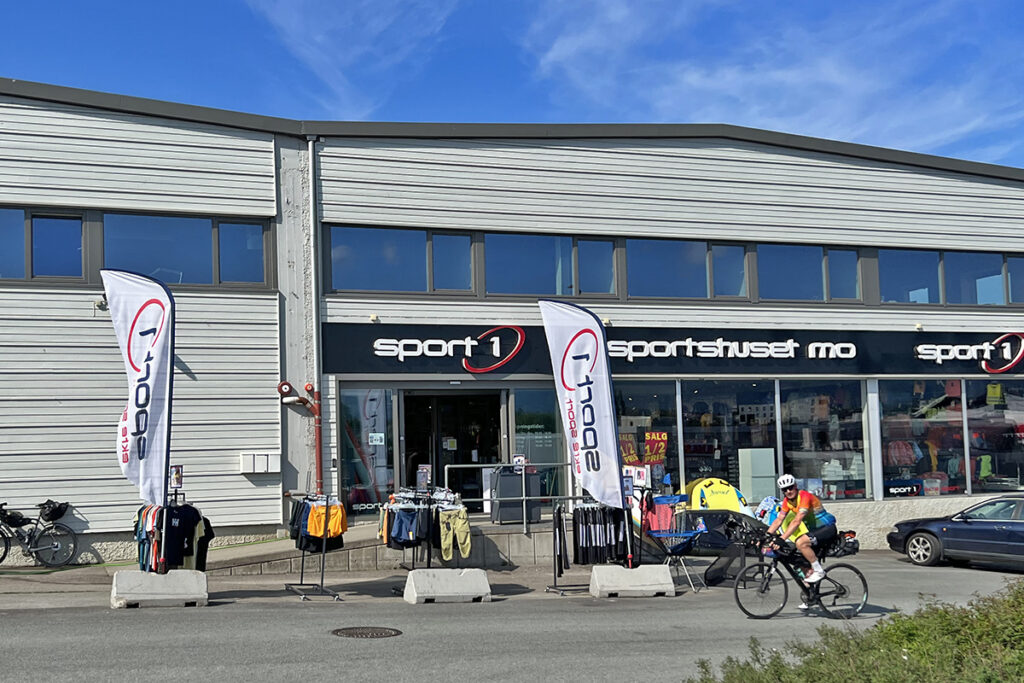
Nature & Fauna
You will have a good chance of seeing moose, reindeer and foxes close to the road, especially in the evening and night. You may also see red deer and roe deer, and in rare cases wolverine, lynx or pine marten; perhaps even grey wolf or brown bear. On the mountain lakes you will find birds such as whooper swan, mute swan, and arctic loon. In farm meadows you may see common crane, Canada geese and greylag geese. In the forests you may see black woodpecker, great spotted woodpecker, common cuckoo, capercaillie and black grouse, but also birds of prey such as boreal owl. You also have a chance of seeing larger birds of prey such as golden eagle and rough-legged hawk. Above the tree line you may see rock ptarmigan. In Norway around Lake Røssvattnet, domestic sheep roam loose on the roads. Down by the sea you will perhaps see a white-tailed eagle soaring above the Ranfjord among arctic tern and several species of gulls.
The right of public access to the wilderness prevails in both Sweden and Norway, which means that it is permitted to both camp and swim in privately owned forests and lakes as long as you do not litter or destroy; or are in close vicinity to private homes (if so, ask permission first). In the mountains, the water in streams is drinkable. However, do not drink from stagnant water. The water should be running and clear.
FAQ
- What kind of food, especially concerning protein sources?
The food will be varied but will include food typical of the region such as fish, moose and reindeer. - Will I need insect repellant during the event? When do they strike?
June is early summer in the mountains so gnats and mosquitoes may not have arrived in full force by then. If there’s no wind and you stop next to a marsh you’ll soon hear them, if they’re there. - How do you get to and from Umeå?
There are regular domestic flights to Umeå via Stockholm. Both from Stockholm Central Station and Arlanda airport it is also possible to take express or night trains to Umeå. Not all trains have spaces for assembled bikes but most if not all trains and buses will allow disassembled bikes in bike bags. At Stockholm Central Station there is a daily bus service to Umeå. There are car rental services both at Stockholm Central Station and Arlanda airport. - Can we rough sleep at controls if no free bed is available?
Yes, you can sleep indoors wherever you find a space. On route you can also sleep outdoors nearly anywhere you choose however, if there’s no wind and you don’t have a tent, mosquitoes be a nuisance. - Which controls will definitely have showers? Free or paid?
All controls that have sleeping facilities have free showers and towels, and most facilities also have saunas. - What about UV? Should we use sunscreen?
You should definitely use sunscreen if it’s a clear day! - Is bottled water necessary?
No need for bottled water. - Can you recommend a good website to check on weather on the Scandinavian peninsula?
The route passes one of the weather stations for the Swedish meteorological and hydrological institute. For mountain weather reports: https://www.smhi.se/q/Mierkenis/Arjeplog/2692001. - At each control, will there be food provided by the organisers or do we need to find food on our own?
There will be a fixed portion of food at all controls included in the entry fee. At some controls extra food and energy bars for the ride can be purchased. Some controls are hotels that have restaurants. You will find a list of suggested places here where you can buy food on route. Check google maps for exact locations. - During the randonnée, do we need to write anything on the brevet cards or will they be stamped when we arrive at controls?
No, you don’t need to write anything on the brevet cards during the ride (only before you start and after you finish). - Does the app use the phone’s GPS for tracking?
Yes, the app does use GPS but is only active when you press a button to check in or check out at controls. It will not drain the batteries on your phone. - Payments on the road. Do I need cash?
You will have limited use for cash. All shops, restaurants and hotels use EMV terminals so payment with Mastercard and Visa is possible. Apple Pay will work fine. - How strongly do you recommend bringing a sleeping mat?
Don’t bring a sleeping mat. Better to focus on extra clothes if it gets cold, wet or both. Remember, the mountains are very exposed with no shelter. - Finishing MSR at Umea past 23:00, what to expect? Hotel 24h desk? Proper food?
Food is provided for at the Umeå Plaza that will get you through the night if you want to go to sleep directly after you finish. Otherwise there is a MAX Burgers (with vegan alternatives) a few hundred meters from the hotel that is open until 02:00. There is also a service station Circle K nearby that serves food which is open 24/7. - Reflective gilet (like the PBP): is it mandatory? It’s not mentioned in the website rules.
You’ll be cycling in constant daylight conditions, day and night. Reflective gilets aren’t mandatory but recommended. Also recommended is a rear light, also during the daytime which makes you easier to spot on roads with traffic or high speed limits. You’ll also need a front light if visibility is poor due to rain, snow or fog but also in the tunnels in Norway. - Where do I pick up my jersey the day before the event?
Jerseys can be picked up at Brännland Inn during the dinner on Saturday. We have a couple of spare jerseys to switch between if your ordered size doesn’t fit. - The website references a need to show proof of a liability insurance policy. We’re not sure what that is. Is that referencing a health insurance policy?
If you have a serious collision and injure someone else, a third-party insurance (public liability, personal liability) will cover you for damage to others and their property (if you are responsible for an accident or damage a parked car), and also cover you for legal costs. A liability insurance may already be included in your travel insurance. If you are a member of a cycling club a liability insurance may already be included in your membership (check if valid abroad). - Are aerobars allowed? If so are there any restrictions on them, e.g. their length cannot exceed the brakes, or some other restrictions?
We don’t have any restrictions concerning aerobars. - The rules state that personal assistance is allowed at controls. Can my partner give me food and clothing etc?
Yes, personal assistance is allowed at controls but not in-between controls. Your partner can wait for you at a control and give you food and clothing, even fix a mechanical problem. But your partner is not allowed to do the same in-between controls. Between controls, you are only allowed to seek help from neutral parties such as other participants and local residents. If you have personal assistance the policy is also normally to inform the organiser in advance.
Tips for the road
- Before the event, study the course in Google Street View, in particular critical road junctions and the location of the controls.
- When cycling conserve energy as much as possible. Try to keep a steady heart rate throughout the brevet. Imagine that you will cycle the second half of the brevet faster than the first.
- Don’t stress, which is also a waste of energy. A brevet is largely a mental test. Don’t count kilometers. Relax and let the brevet take the time it takes. Subdivide the distance into shorter stage goals and focus on them.
- Try to be organised at controls as time spent here is included in your overall ride time. Plan your stops in advance and be efficient. Over time you’ll pay for the effort of riding faster in order to make up time spent at controls.
- Plan your food and fluid intake long-term. Do not leave a control without refilling supplies and water bottles. Always carry reserve supplies in case of something unforeseen happens between controls. That said, help from residents along the course is allowed, such as refilling water bottles or repairing a bike, even between controls.
- Don’t forget to register at the controls! Check in at the controls and make sure that your brevet card is signed and/or stamped BEFORE you do anything else, for instance eat, sleep or visit the toilet etc.
The organiser Randonneurs Laponia wishes you a safe journey and good luck!
